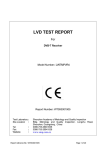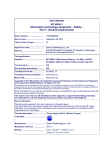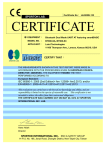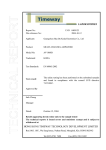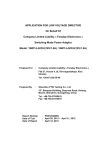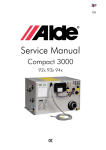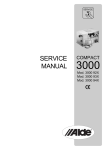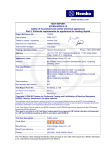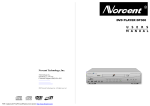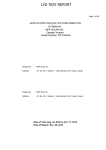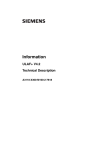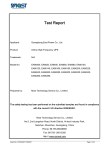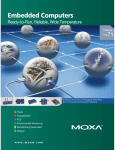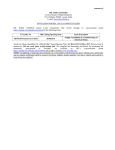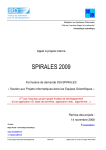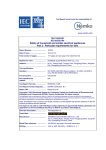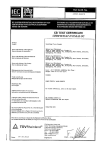Download LVD Report__A2 2013_YS902672
Transcript
Report No.: T1505073-051 Particulars: test item vs. test requirements Equipment mobility ....................................................: Transportable and movable Connection to the mains............................................: non-detachable power supply cord Operating condition ...................................................: Continuous Access location .........................................................: Operator accessible Over voltage category (OVC) ...................................: II Mains supply tolerance (%) or absolute mains supply -10%, +10% values .......................................................................: Tested for IT power systems ....................................: N/A IT testing, phase-phase voltage (V) .........................: N/A Class of equipment ...................................................: Class II Considered current rating (A) ...................................: 16A Pollution degree (PD) ...............................................: PD2 IP protection class ....................................................: IPX0 Altitude during operation (m) ....................................: Up to 2000 Altitude of test laboratory (m) ...................................: Below 2000 Mass of equipment (kg) ............................................: Approx. 0.245 Possible test case verdicts: - test case does not apply to the test object................. : N/A - test object does meet the requirement....................... : P (Pass) - test object does not meet the requirement................. : F (Fail) Testing Date of receipt of test item ............................................ : 2015-05-16 Date(s) of performance of tests .................................... : 2015-05-16 to 2015-05-20 Rev 2.0 Page 2 of 73 Report No.: T1505073-051 General remarks: If any questions of the inspection report, please proposed with in 15 days from receiving the report, deadline will not be accepted. Report would be inefficiency if any scrawling or modification was made. The test results presented in this report relate only to the object tested. This report shall not be reproduced, except in full, without the written approval of the Issuing testing laboratory. "(see Enclosure #)" refers to additional information appended to the report. "(see appended table)" refers to a table appended to the report. Throughout this report a point is used as the decimal separator. The instructions specified by the standard have to be in official language of each country, however, only English is checked for this report. It is the applicant responsibility to provide instruction in each official language of the EU. This report is submitted for the exclusive use of the client to whom it is addressed. Its significance is subject to the adequacy and representative character of the sample(s) and to the comprehensiveness of the tests, examinations or surveys made. This report justified only the submitted samples exclusively and not necessarily implies that all other samples are also to be found in same result. The CE marking may only be used if all relevant and effective EC directives are complied with. Rev 2.0 Page 3 of 73 Report No.: T1505073-051 Factor(ies): Yesa Technology Co., Ltd No. 1504, Launch Industrail Zone, North Of Wuhe Rd, Bantian, Longgang, Shenzhen, China General product information: The equipment is transportable type Battery charger used for information technology equipment. The equipment’s top enclosure is secured to bottom enclosure by screw. The manufacturer declared that the maximum ambient temperature is 35°C. Other comments: None Rev 2.0 Page 4 of 73 Report No.: T1505073-051 Copy of marking plate and summary of test results (information/comments): Note(s): The above label is a draft of an artwork for marking plate pending approval by National Certification Bodies and it shall not be affixed to products prior to such an approval. Rev 2.0 Page 5 of 73 Report No.: T1505073-051 IEC 60950-1 Clause Requirement + Test 1 GENERAL P 1.5 Components P 1.5.1 General See below. P Comply with IEC 60950-1 or relevant component standard (see appended tables 1.5.1) P 1.5.2 Evaluation and testing of components Components certified to IEC standards and/or their harmonized standards, are used within their ratings and are checked for correct application. Components, which no relevant IECStandard exists, are used within their ratings and are tested under the conditions occurring in the equipment P 1.5.3 Thermal controls No thermal controls. 1.5.4 Transformers Transformer used are suitable for their intended application and comply with the relevant requirements of the standard and particularly Annex C. 1.5.5 Interconnecting cables Not such cables used. N/A 1.5.6 Capacitors bridging insulation No such components. N/A 1.5.7 Resistors bridging insulation No such components N/A 1.5.7.1 Resistors bridging functional, basic or supplementary insulation 1.5.7.2 Resistors bridging double or reinforced insulation between a.c. mains and other circuits No such components. N/A 1.5.7.3 Resistors bridging double or reinforced insulation between a.c. mains and antenna or coaxial cable No such components. N/A 1.5.8 Components in equipment for IT power systems No such components. N/A 1.5.9 Surge suppressors No such components. N/A 1.5.9.1 General No such components. N/A 1.5.9.2 Protection of VDRs N/A 1.5.9.3 Bridging of functional insulation by a VDR N/A 1.5.9.4 Bridging of basic insulation by a VDR Rev 2.0 Result - Remark Page 6 of 73 Verdict N/A P N/A No such components. N/A Report No.: T1505073-051 IEC 60950-1 Clause Requirement + Test Result - Remark 1.5.9.5 Bridging of supplementary, double or reinforced insulation by a VDR No such components. 1.6 Power interface 1.6.1 AC power distribution systems TN power system. P 1.6.2 Input current Highest load according to 1.2.2.1 for this equipment is the operation with the max. specified DC-load. (see appended table 1.6.2) P 1.6.3 Voltage limit of hand-held equipment Not hand-held equipment. 1.6.4 Neutral conductor Class II equipment. The neutral is not identified in the equipment. Double or reinforced insulation for rated voltage between accessible parts and primary phases. 1.7 Marking and instructions P 1.7.1 Power rating and identification markings P 1.7.1.1 Power rating marking See below N/A P P N/A Rated voltage(s) or voltage range(s) (V) ...............: AC 220-240V Symbol for nature of supply, for d.c. only...............: Mains from AC source Rated frequency or rated frequency range (Hz) ....: 50/60Hz P Rated current (mA or A) .........................................: 350mA P Identification markings See below P P N/A P Manufacturer’s name or trade-mark or identification mark .......................................................................: Rev 2.0 N/A P Multiple mains supply connections..........................: Only one mains supply connections. 1.7.1.2 Verdict Model identification or type reference ...................: YS902672 P Symbol for Class II equipment only .......................: Double square symbol provided. P Other markings and symbols ................................: Additional symbols or marking do not give rise to misunderstanding. P Page 7 of 73 Report No.: T1505073-051 IEC 60950-1 Clause Requirement + Test Result - Remark 1.7.1.3 Use of graphical symbols Graphical symbols are all explained in the user’s manual. P 1.7.2 Safety instructions and marking See below. P 1.7.2.1 General P 1.7.2.2 Disconnect devices 1.7.2.3 Overcurrent protective device The user’s manual contains information for operation, installation, servicing, transport, storage and technical data. The operation guide is provided to the user. The mains plug is regarded as disconnected device and it is incorporated with equipment during normal use. Pluggable equipment type A 1.7.2.4 IT power distribution systems It shall be evaluated when submitted for Norway national approval. N/A 1.7.2.5 Operator access with a tool No operator accessible area that needs to be accessed by the use of a tool. N/A 1.7.2.6 Ozone The equipment not containing Ozone. N/A 1.7.3 Short duty cycles The equipment is intended for continuous operation. N/A 1.7.4 Supply voltage adjustment ...................................: No voltage selector. N/A Methods and means of adjustment; reference to installation instructions .........................................: Verdict P N/A N/A 1.7.5 Power outlets on the equipment ...........................: No power outlets provided. 1.7.6 Fuse identification (marking, special fusing characteristics, cross-reference) ..........................: Current fuse (F1) used, marking adjacent to it: T1A/250Vac. 1.7.7 Wiring terminals No such terminals N/A 1.7.7.1 Protective earthing and bonding terminals ...........: Class II equipment. N/A 1.7.7.2 Terminals for a.c. mains supply conductors No such terminals. N/A 1.7.7.3 Terminals for d.c. mains supply conductors AC mains supply only. N/A 1.7.8 Controls and indicators No safety relevant controls or indicators N/A 1.7.8.1 Identification, location and marking.......................: N/A 1.7.8.2 Colours .................................................................: N/A Rev 2.0 Page 8 of 73 N/A P Report No.: T1505073-051 IEC 60950-1 Clause Requirement + Test Result - Remark Verdict 1.7.8.3 Symbols according to IEC 60417.........................: There are no mains switches in the equipment. N/A 1.7.8.4 Markings using figures ........................................: No controls affecting safety. N/A 1.7.9 Isolation of multiple power sources ......................: Only one supply from the mains. N/A 1.7.10 Thermostats and other regulating devices ..........: No thermostats or other regulating devices. N/A 1.7.11 Durability he label was subjected to the permanence of marking test. The label was rubbed with cloth soaked with water for 15 s and then again for 15s with the cloth soaked with petroleum spirit. P After this test there was no damage to the label. The marking on the label did not fade. There was neither curling nor lifting of the label edge 1.7.12 Removable parts No removable parts provided. N/A 1.7.13 Replaceable batteries ..........................................: No battery provided. N/A ⎯ Language(s) ........................................................ : 1.7.14 Equipment for restricted access locations ...........: 2 PROTECTION FROM HAZARDS P 2.1 Protection from electric shock and energy hazards P 2.1.1 Protection in operator access areas See below P 2.1.1.1 Access to energized parts See below. P Test by inspection .................................................: No access with test finger and test pin to any parts with only basic insulation to ELV or hazardous voltage. P Test with test finger (Figure 2A) ............................: See above. P Test with test pin (Figure 2B) ................................: See above. P Test with test probe (Figure 2C) ............................: No TNV circuits in the equipment. N/A Battery compartments No battery compartments N/A 2.1.1.2 Rev 2.0 Page 9 of 73 No restricted access location. N/A Report No.: T1505073-051 IEC 60950-1 Clause Requirement + Test Result - Remark 2.1.1.3 Access to ELV wiring No ELV wiring in operator accessible area. Working voltage (Vpeak or Vrms); minimum distance through insulation (mm) see appended tables 2.10.2 and 2.10.5 ⎯ 2.1.1.4 Access to hazardous voltage circuit wiring No hazardous voltage wiring in operator accessible area. N/A 2.1.1.5 Energy hazards .....................................................: Energy does not exceed 240VA between any two points in accessible parts (o/p connector of secondary circuit). Results see appended table 2.1.1.5. No energy hazard in operator access area. P 2.1.1.6 Manual controls Not connected to and sufficiently separated from hazardous voltages. 2.1.1.7 Discharge of capacitors in equipment 2.1.1.8 Verdict N/A N/A P Measured voltage (V); time-constant (s) ................: (see appended table 2.1.1.7) Energy hazards – d.c. mains supply Connected to a.c. mains. ⎯ N/A a) Capacitor connected to the d.c. mains supply ..: N/A b) Internal battery connected to the d.c. mains supply ....................................................................: N/A 2.1.1.9 Audio amplifiers .....................................................: No Audio amplifiers. N/A 2.1.2 Protection in service access areas N/A 2.1.3 Protection in restricted access locations No service access areas. No restricted access locations. 2.2 SELV circuits 2.2.1 General requirements See below. P 2.2.2 Voltages under normal conditions (V) ...................: Between any conductors of the SELV circuits 42.4 V peak or 60 V d.c. are not exceeded. (See appended table 2.2.2.) P Rev 2.0 N/A P Page 10 of 73 Report No.: T1505073-051 IEC 60950-1 Clause Requirement + Test Result - Remark Verdict 2.2.3 Voltages under fault conditions (V) .......................: Single fault did not cause excessive voltage in accessible SELV circuits. Limits of 71V peak and 120V d.c. were not exceeded within 0.2 seconds and limits 42.4V peak and 60V d.c. were not exceeded for longer than 0.2 seconds. P 2.2.4 Connection of SELV circuits to other circuits ......: See above. P 2.3 TNV circuits 2.3.1 Limits See below. Type of TNV circuits ...............................................: No TNV circuits in the equipment. N/A N/A ⎯ 2.3.2 Separation from other circuits and from accessible parts N/A 2.3.2.1 General requirements N/A 2.3.2.2 Protection by basic insulation N/A 2.3.2.3 Protection by earthing N/A 2.3.2.4 Protection by other constructions ..........................: N/A 2.3.3 Separation from hazardous voltages N/A ⎯ Insulation employed ...............................................: 2.3.4 Connection of TNV circuits to other circuits N/A ⎯ Insulation employed ...............................................: 2.3.5 Test for operating voltages generated externally 2.4 Limited current circuits P 2.4.1 General requirements P 2.4.2 Limit values See below P Frequency (Hz).......................................................: (see appended table 2.4.2) ⎯ Measured current (mA) ..........................................: (see appended table 2.4.2) ⎯ Measured voltage (V) .............................................: (see appended table 2.4.2) ⎯ Measured circuit capacitance (nF or µF) ...............: CY1=2200pF ⎯ Connection of limited current circuits to other circuits See 2.2.2 and 2.2.3. No direct connection between SELV and any primary circuits. P 2.4.3 Rev 2.0 Page 11 of 73 N/A Report No.: T1505073-051 IEC 60950-1 Clause Requirement + Test Result - Remark Verdict 2.5 Limited power sources N/A a) Inherently limited output N/A b) Impedance limited output N/A c) Regulating network limited output under normal operating and single fault condition Use of integrated circuit (IC) current limiters N/A d) Overcurrent protective device limited output N/A Max. output voltage (V), max. output current (A), max. apparent power (VA) .....................................: N/A Current rating of overcurrent protective device (A) .: No such parts used. N/A 2.6 Provisions for earthing and bonding N/A 2.6.1 Protective earthing 2.6.2 Functional earthing N/A Use of symbol for functional earthing ...................: N/A N/A Class II equipment. N/A 2.6.3 Protective earthing and protective bonding conductors ⎯ 2.6.3.1 General ⎯ 2.6.3.2 Size of protective earthing conductors N/A 2 Rated current (A), cross-sectional area (mm ), AWG .......................................................................: 2.6.3.3 Size of protective bonding conductors ⎯ N/A 2 Rated current (A), cross-sectional area (mm ), AWG .......................................................................: ⎯ Protective current rating (A), cross-sectional area (mm2), AWG ...........................................................: ⎯ 2.6.3.4 Resistance of earthing conductors and their terminations; resistance (Ω), voltage drop (V), test current (A), duration (min) ......................................: N/A 2.6.3.5 Colour of insulation.................................................: N/A 2.6.4 Terminals ⎯ 2.6.4.1 General ⎯ 2.6.4.2 Protective earthing and bonding terminals ⎯ Rated current (A), type, nominal thread diameter (mm) .......................................................................: Rev 2.0 Page 12 of 73 N/A Report No.: T1505073-051 IEC 60950-1 Clause Requirement + Test 2.6.4.3 Separation of the protective earthing conductor from protective bonding conductors 2.6.5 Integrity of protective earthing ⎯ 2.6.5.1 Interconnection of equipment N/A 2.6.5.2 Components in protective earthing conductors and protective bonding conductors N/A 2.6.5.3 Disconnection of protective earth N/A 2.6.5.4 Parts that can be removed by an operator N/A 2.6.5.5 Parts removed during servicing N/A 2.6.5.6 Corrosion resistance N/A 2.6.5.7 Screws for protective bonding N/A 2.6.5.8 Reliance on telecommunication network or cable distribution system N/A 2.7 Overcurrent and earth fault protection in primary circuits P 2.7.1 Basic requirements Equipment relies on 16A rated fuse or circuit breaker of the wall outlet installation protection of the building installation in regard to L to N short circuit. Over-current protection is provided by the current fuse. P Instructions when protection relies on building installation The final system is considered to be pluggable equipment type A. N/A 2.7.2 Faults not simulated in 5.3.7 The protection device is well dimensioned and mounted. P 2.7.3 Short-circuit backup protection Pluggable equipment type A. Building installation is considered as providing shortcircuit backup protection. P 2.7.4 Number and location of protective devices ............: Over current protection by one built-in current fuse. P 2.7.5 Protection by several devices Only one protective device. See Sub-clause 2.7.4. N/A 2.7.6 Warning to service personnel.................................: N/A 2.8 Safety interlocks N/A Rev 2.0 Result - Remark Page 13 of 73 Verdict N/A Report No.: T1505073-051 IEC 60950-1 Clause Requirement + Test Result - Remark Verdict 2.8.1 General principles No safety interlock provided. 2.8.2 Protection requirements N/A 2.8.3 Inadvertent reactivation N/A 2.8.4 Fail-safe operation N/A Protection against extreme hazard N/A 2.8.5 Moving parts N/A 2.8.6 Overriding N/A 2.8.7 Switches, relays and their related circuits N/A 2.8.7.1 Separation distances for contact gaps and their related circuits (mm) : N/A 2.8.7.2 Overload test N/A 2.8.7.3 Endurance test N/A 2.8.7.4 Electric strength test N/A 2.8.8 Mechanical actuators N/A 2.9 Electrical insulation P 2.9.1 Properties of insulating materials Natural rubber, asbestos or hygroscopic material are not used. P 2.9.2 Humidity conditioning Humidity treatment performed at 120 h P Relative humidity (%), temperature (°C) ...............: 93%, 40°C ⎯ 2.9.3 Grade of insulation Please refer to 2.10, 4.5.1 and 5.2 P 2.9.4 Separation from hazardous voltages The secondary circuit is separated from hazardous voltages by reinforce insulation. P Method(s) used .....................................................: Method 1 used ⎯ N/A 2.10 Clearances, creepage distances and distances through insulation P 2.10.1 General See below. P 2.10.1.1 Frequency ..............................................................: Considered. P 2.10.1.2 Pollution degrees ...................................................: 2 P 2.10.1.3 Reduced values for functional insulation The functional are comply with 5.3.4 a) and c) P Rev 2.0 Page 14 of 73 Report No.: T1505073-051 IEC 60950-1 Clause Requirement + Test Result - Remark 2.10.1.4 Intervening unconnected conductive parts No such part. N/A 2.10.1.5 Insulation with varying dimensions No such insulations. N/A 2.10.1.6 Special separation requirements Not used. N/A 2.10.1.7 Insulation in circuits generating starting pulses No such part. N/A 2.10.2 Determination of working voltage See below. P 2.10.2.1 General Considered. P 2.10.2.2 RMS working voltage (see appended table 2.10.2) P 2.10.2.3 Peak working voltage (see appended table 2.10.2) P 2.10.3 Clearances See below. P 2.10.3.1 General See below, Annex G was not considered. P 2.10.3.2 Mains transient voltages See below. P a) AC mains supply ...............................................: Normal transient voltage considered (overvoltage category II for primary circuit). P b) Earthed d.c. mains supplies ..............................: Not intended for d.c. N/A c) Unearthed d.c. mains supplies ..........................: Not intended for d.c. N/A d) Battery operation ...............................................: Verdict N/A 2.10.3.3 Clearances in primary circuits Annex F and minimum clearances considered. (see appended table 2.10.3 and 2.10.4) P 2.10.3.4 Clearances in secondary circuits See 5.3.4. P 2.10.3.5 Clearances in circuits having starting pulses No such circuit. 2.10.3.6 Transients from a.c. mains supply ........................: N/A 2.10.3.7 Transients from d.c. mains supply ........................: N/A 2.10.3.8 Transients from telecommunication networks and cable distribution systems .....................................: 2.10.3.9 Measurement of transient voltage levels N/A a) Transients from a mains suplply N/A For an a.c. mains supply .......................................: N/A For a d.c. mains supply .........................................: N/A b) Transients from a telecommunication network : N/A 2.10.4 2.10.4.1 Rev 2.0 Creepage distances General Page 15 of 73 No TNV circuits in the equipment. N/A N/A (see appended table 2.10.3 and 2.10.4) P See below. P Report No.: T1505073-051 IEC 60950-1 Clause Requirement + Test Result - Remark 2.10.4.2 Material group and caomparative tracking index Material group IIIb is assumed to be used P CTI tests .................................................................: CTI rating for all materials are min. 100. ⎯ 2.10.4.3 Minimum creepage distances (see appended table 2.10.3 and 2.10.4) P 2.10.5 Solid insulation 2.10.5.1 General See below. P 2.10.5.2 Distances through insulation (see appended table 2.10.5) P 2.10.5.3 Insulating compound as solid insulation No such components. 2.10.5.4 Semiconductor devices Approved optocoupler with dti. ≥0.4mm used. 2.10.5.5. Cemented joints No cemented joints. 2.10.5.6 Thin sheet material – General The thin sheet materials of polyester tape used in transformer T1. P 2.10.5.7 Separable thin sheet material Two layers of polyester tape wrapped around the body of transformer T1 were used as reinforced insulation. P Number of layers (pcs) ...........................................: 2 layers. ⎯ 2.10.5.8 Non-separable thin sheet material Not applicable. N/A 2.10.5.9 Thin sheet material – standard test procedure Not applicable. N/A Electric strength test Not applicable. ⎯ 2.10.5.10 Verdict P Thin sheet material – alternative test procedure N/A P N/A P Electric strength test (See appended table 5.2) P 2.10.5.11 Insulation in wound components Approved source of triple insulated wire used in T1 primary winding for reinforced insulation. P 2.10.5.12 Wire in wound components See above. P Working voltage See appended table C.2 in Measurement Section. P : a) Basic insulation not under stress ......................: b) Basic, supplemetary, reinforced insulation .......: Rev 2.0 Page 16 of 73 N/A Reinforced insulation. P Report No.: T1505073-051 IEC 60950-1 Clause 2.10.5.13 2.10.5.14 Requirement + Test Result - Remark Verdict c) Compliance with Annex U .................................: Approved source of triple insulated wire used in T1 primary winding for reinforced insulation. P Two wires in contact inside wound component; angle between 45° and 90° ...................................: By tubing or insulation tape. P Wire with solvent-based enamel in wound components No such parts. N/A Electric strength test ⎯ Routine test ⎯ Additional insulation in wound components No such construction. N/A Working voltage .....................................................: N/A - Basic insulation not under stress ........................: N/A - Supplemetary, reinforced insulation ....................: N/A 2.10.6 Construction of printed boards See below. P 2.10.6.1 Uncoated printed boards (see appended table 2.10.3 and 2.10.4) P 2.10.6.2 Coated printed boards No such parts. N/A 2.10.6.3 Insulation between conductors on the same inner surface of a printed board No such parts. N/A 2.10.6.4 Insulation between conductors on different layers of a printed board No such parts. N/A Distance through insulation ⎯ Number of insulation layers (pcs)...........................: ⎯ 2.10.7 Component external terminations No such parts. N/A 2.10.8 Tests on coated printed boards and coated components No such parts. N/A 2.10.8.1 Sample preparation and preliminary inspection N/A 2.10.8.2 Thermal conditioning N/A 2.10.8.3 Electric strength test N/A 2.10.8.4 Abrasion resistance test N/A 2.10.9 Thermal cycling N/A 2.10.10 Test for Pollution Degree 1 environment and insulating compound 2.10.11 Tests for semiconductor devices and cemented joints Rev 2.0 Page 17 of 73 No such components. N/A N/A Report No.: T1505073-051 IEC 60950-1 Clause Requirement + Test 2.10.12 Enclosed and sealed parts 3 WIRING, CONNECTIONS AND SUPPLY P 3.1 General P 3.1.1 Current rating and overcurrent protection All internal wires are UL recognized wiring which is PVC insulated, rated VW-1, minimum 80°C. Internal wiring gauge is suitable for current intended to be carried. P 3.1.2 Protection against mechanical damage Wires do not touch sharp edges, which could damage the insulation. P 3.1.3 Securing of internal wiring Internal wiring is secured reliable so that loosening of terminal connections is unlikely. P 3.1.4 Insulation of conductors Insulation of the conductor is suitable for the application. For insulation material see subclause 3.1.1. P 3.1.5 Beads and ceramic insulators Not used. N/A 3.1.6 Screws for electrical contact pressure No such screws. N/A 3.1.7 Insulating materials in electrical connections All current carrying connections are metal to metal. N/A 3.1.8 Self-tapping and spaced thread screws No such part. N/A 3.1.9 Termination of conductors All conductors are reliably secured by solder-pin or glued or other mechanical fixing means. P 10 N pull test Break away or pivot on its terminal is unlikely. P 3.1.10 Sleeving on wiring No sleeving used to provide supplementary insulation. 3.2 Connection to a mains supply 3.2.1 Means of connection See below P 3.2.1.1 Connection to an a.c. mains supply Non-detachable power supply cord with plug P Rev 2.0 Result - Remark Verdict N/A N/A P Page 18 of 73 Report No.: T1505073-051 IEC 60950-1 Clause Requirement + Test Result - Remark Verdict 3.2.1.2 Connection to a d.c. mains supply AC Source. N/A 3.2.2 Multiple supply connections Only one supply connection N/A 3.2.3 Permanently connected equipment The equipment is not intended for permanent connection to the mains. N/A ⎯ Number of conductors, diameter of cable and conduits (mm) ....................................................... : 3.2.4 Appliance inlets N/A 3.2.5 Power supply cords Non-detachable power supply cord P 3.2.5.1 AC power supply cords (see appended table 1.5.1.) P Type ...................................................................... : (see appended table 1.5.1.) ⎯ Rated current (A), cross-sectional area (mm ), AWG ..................................................................... : (see appended table 1.5.1.) ⎯ 3.2.5.2 DC power supply cords No connected to DC mains N/A 3.2.6 Cord anchorages and strain relief Test on non-detachable power supply cords. After the test, there was no indication of damage and not displaced more than 2mm. The equipment complies with the requirements of electric strength test. P Mass of equipment (kg), pull (N) ......................... : 0.245, 30N ⎯ Longitudinal displacement (mm) .......................... : 0.12 max. ⎯ 3.2.7 Protection against mechanical damage No arts under this unit likely to damage the power supply cord. No sharp edges. N/A 3.2.8 Cord guards Integral cord guard is provided on power supply cord N/A 2 3.2.9 Rev 2.0 Diameter or minor dimension D (mm); test mass (g) 3.5mm; 122.5g ............................................................................... : ⎯ Radius of curvature of cord (mm).......................... : 6.0mm ⎯ Supply wiring space Cord guard is provided that prevent the wiring not be damaged and be free from its terminal. P Page 19 of 73 Report No.: T1505073-051 IEC 60950-1 Clause Requirement + Test 3.3 Wiring terminals for connection of external conductors P 3.3.1 Wiring terminals P 3.3.2 Connection of non-detachable power supply cords 3.3.3 Screw terminals 3.3.4 Conductor sizes to be connected See below. P Rated current (A), cord/cable type, cross-sectional area (mm2)............................................................. : (See appended table 1.5.1.) ⎯ Wiring terminal sizes No such wiring terminal. Supply cord is soldered on PCB and additionally fixed by glue. N/A 3.3.5 Result - Remark No special non-detachable power supply cord used. Verdict N/A N/A ⎯ Rated current (A), type, nominal thread diameter (mm) ..................................................................... : 3.3.6 Wiring terminal design N/A 3.3.7 Grouping of wiring terminals N/A 3.3.8 Stranded wire 3.4 Disconnection from the mains supply 3.4.1 General requirement See below. P 3.4.2 Disconnect devices The mains plug on the power cord is regarded as disconnected device and it is incorporated with equipment during normal use. P 3.4.3 Permanently connected equipment Not permanently connected equipment. 3.4.4 Parts which remain energized There is no parts remained with hazardous voltage or energy in the equipment when SPS is separated from AC mains. 3.4.5 Switches in flexible cords 3.4.6 Number of poles – single-phase and d.c. equipment See sub-clause 1.7.2.2. The disconnected device disconnects both poles simultaneously. 3.4.7 Number of poles – three-phase equipment Single phase. Rev 2.0 The conductor is not subject to contact pressure. N/A P N/A P N/A Page 20 of 73 P N/A Report No.: T1505073-051 IEC 60950-1 Clause Requirement + Test Result - Remark 3.4.8 Switches as disconnect devices No switches provided. N/A 3.4.9 Plugs as disconnect devices (see sub-clause 3.4.2) P 3.4.10 Interconnected equipment No interconnections using hazardous voltages. N/A 3.4.11 Multiple power sources Only one supply connection provided. N/A 3.5 Interconnection of equipment 3.5.1 General requirements Considered. P 3.5.2 Types of interconnection circuits .......................... : SELV Circuit. P 3.5.3 ELV circuits as interconnection circuits No ELV interconnection. N/A 3.5.4 Data ports for additional equipment No data ports. N/A 4 PHYSICAL REQUIREMENTS P 4.1 Stability P P Angle of 10 Less than 7kg. Test force (N) ........................................................: 4.2 Mechanical strength 4.2.1 General Steady force test, 10 N 4.2.3 Steady force test, 30 N 4.2.4 Steady force test, 250 N 4.2.5 Impact test Rev 2.0 N/A N/A P See below. After the tests, the equipment complies with the requirements of sub-clauses 2.1.1, 2.6.1, 2.10 and 4.4.1. No such equipment 10 N applied to all components other than the parts serving as an enclosure. No internal enclosure Rack-mounted equipment. 4.2.2 Verdict P N/A P N/A Fall test 250N applied to outer enclosure. No energy or other hazards. Test was performed for all sources of enclosure material. Not applied for direct plug-in equipment. See above. N/A Swing test See above. N/A Page 21 of 73 P N/A Report No.: T1505073-051 IEC 60950-1 Clause Requirement + Test Result - Remark 4.2.6 Drop test; height (mm) ...........................................: 4.2.7 Stress relief test The equipment has been subjected to three drops from 1m height on a hard wooden surface. No hazard as result from drop test. After 7 hours at temperature of 85°C and cooling down to room temperature, no shrinkage, distortion or loosening any enclosure part was noticeable on the equipment. 4.2.8 Cathode ray tubes No cathode ray tube. Picture tube separately certified ............................: Verdict P P N/A N/A 4.2.9 High pressure lamps No high pressure lamp. N/A 4.2.10 Wall or ceiling mounted equipment; force (N) .......: Not wall or ceiling mounted equipment. N/A 4.3 Design and construction 4.3.1 Edges and corners All edges and corners are rounded and/or smoothed 4.3.2 Handles and manual controls; force (N) ............ : No handles or controls provided. N/A 4.3.3 Adjustable controls No adjustable controls. N/A 4.3.4 Securing of parts No loosening of parts impairing creepage distances or clearances is likely to occur P 4.3.5 Connection by plugs and sockets No mismating of connectors, plugs or sockets possible. P 4.3.6 Direct plug-in equipment Not direct plug-in equipment. N/A P P Torque ..................................................................: N/A Compliance with the relevant mains plug standard ...............................................................................: N/A 4.3.7 Heating elements in earthed equipment No heating elements provided N/A 4.3.8 Batteries No battery provided. N/A Rev 2.0 - Overcharging of a rechargeable battery N/A - Unintentional charging of a non-rechargeable battery N/A Page 22 of 73 Report No.: T1505073-051 IEC 60950-1 Clause Requirement + Test Result - Remark Verdict - Reverse charging of a rechargeable battery N/A - Excessive discharging rate for any battery N/A 4.3.9 Oil and grease Insulation is not exposed to oil and grease etc N/A 4.3.10 Dust, powders, liquids and gases The equipment does not contain flammable liquids or gases N/A 4.3.11 Containers for liquids or gases No containers for liquids or gases in the equipment N/A 4.3.12 Flammable liquids ................................................: The equipment does not contain flammable liquid N/A Quantity of liquid (l) ..............................................: N/A Flash point (°C) ....................................................: N/A 4.3.13 Radiation 4.3.13.1 General 4.3.13.2 Ionizing radiation 4.3.13.3 No radiation hazards. N/A ⎯ No ionizing radiation or flammable liquids present. N/A Measured radiation(pA/kg) ...................................: ⎯ Measured high-voltage (kV) ..................................: ⎯ Measured focus voltage (kV) ................................: ⎯ CRT markings .......................................................: ⎯ Effect of ultraviolet (UV) radiation on materials No UV radiation. N/A Part, property, retention after test, flammability classification .........................................................: N/A 4.3.13.4 Human exposure to ultraviolet (UV) radiation ......: N/A 4.3.13.5 Lasers (including laser diodes) and LEDs 4.3.13.5.1 Lasers (including laser laser diodes) The LED is considered as indicating light. N/A ⎯ Laser class ...........................................................: 4.3.13.5.2 Light emitting diodes (LEDs) The output radiation of the LED indicator (optional) is far less than the limit of laser class 1. 4.3.13.6 Other types ...........................................................: Not used. 4.4 Protection against hazardous moving parts Rev 2.0 Page 23 of 73 P P N/A N/A Report No.: T1505073-051 IEC 60950-1 Clause Requirement + Test Result - Remark Verdict 4.4.1 General No moving parts. N/A 4.4.2 Protection in operator access areas ....................: N/A Household and home/office document/media shredders N/A 4.4.3 Protection in restricted access locations ..............: N/A 4.4.4 Protection in service access areas N/A 4.4.5 Protection against moving fan blades N/A 4.4.5.1 General N/A Not considered to cause pain or injury. a)………….: N/A Is considered to cause pain, not injury. b) …………: N/A Considered to cause injury. c) …………: N/A Protection for users N/A Use of symbol or warning ……………………………: N/A Protection for service persons N/A Use of symbol or warning ……………………………: N/A 4.4.5.2 4.4.5.3 P 4.5 Thermal requirements 4.5.1 General See below. P 4.5.2 Temperature tests (see appended table 4.5) P Normal load condition per Annex L ......................: See Annex L. ⎯ 4.5.3 Temperature limits for materials (see appended table 4.5) P 4.5.4 Touch temperature limits (see appended table 4.5) P 4.5.5 Resistance to abnormal heat .................................... Phenolic bobbin material used in Transformer T1, which acceptable without test. No other parts to be tested. 4.6 Openings in enclosures 4.6.1 Top and side openings P No openings. Rev 2.0 Bottoms of fire enclosures (see appended table 4.6.1) Page 24 of 73 N/A ⎯ Dimensions (mm) .................................................: 4.6.2 N/A P Report No.: T1505073-051 IEC 60950-1 Clause Requirement + Test Result - Remark Verdict ⎯ Construction of the bottomm, dimensions (mm) ..: 4.6.3 Doors or covers in fire enclosures No doors or covers provided. N/A 4.6.4 Openings in transportable equipment Not applicable. N/A 4.6.4.1 Constructional design measures N/A ⎯ Dimensions (mm) .................................................: 4.6.4.2 Evaluation measures for larger openings N/A 4.6.4.3 Use of metallized parts N/A 4.6.5 Adhesives for constructional purposes No adhesives for constructional purposes. N/A Conditioning temperature (°C), time (weeks)........: ⎯ 4.7 Resistance to fire P 4.7.1 Reducing the risk of ignition and spread of flame Use of materials with the required flammability classes. Method 1, selection and application of components (see appended table 4.7) wiring and materials Method 2, application of all of simulated fault condition tests P P N/A 4.7.2 Conditions for a fire enclosure See below. P 4.7.2.1 Parts requiring a fire enclosure With having the following parts: P - Components in primary - Components in secondary - Components having unenclosed arcing parts at hazardous voltage or energy level. - Insulated wiring The fire enclosure is required. 4.7.2.2 Parts not requiring a fire enclosure 4.7.3 Materials 4.7.3.1 General Parts mounted on PCB of flammability class V-1 or better. P 4.7.3.2 Materials for fire enclosures V-1 or better. P Rev 2.0 All parts are located inside a fire enclosure. N/A P Page 25 of 73 Report No.: T1505073-051 IEC 60950-1 Clause Requirement + Test Result - Remark 4.7.3.3 Materials for components and other parts outside fire enclosures No such component. 4.7.3.4 Materials for components and other parts inside fire enclosures Other materials inside fire enclosure are minimum V-2 material. 4.7.3.5 Materials for air filter assemblies No air filter. N/A 4.7.3.6 Materials used in high-voltage components No high-voltage components. N/A 5 ELECTRICAL REQUIREMENTS AND SIMULATED ABNORMAL CONDITIONS P 5.1 Touch current and protective conductor current P 5.1.1 General 5.1.2 Configuration of equipment under test (EUT) P 5.1.2.1 Single connection to an a.c. mains supply P 5.1.2.2 Redundant multiple connections to an a.c. mains supply N/A 5.1.2.3 Simultaneous multiple connections to an a.c. mains supply N/A 5.1.3 Test circuit Equipment of figure 5A used. P 5.1.4 Application of measuring instrument Using measuring instrument in annex D. P 5.1.5 Test procedure The touch current was measured from mains to secondary circuit and enclosure. P 5.1.6 Test measurements See below. P Supply voltage (V) ................................................: (see appended table 5.1.6) ⎯ Measured touch current (mA) ..............................: (see appended table 5.1.6) ⎯ Max. allowed touch current (mA) .........................: (see appended table 5.1.6) ⎯ See sub-clauses 5.1.2 to 5.1.6. Verdict N/A P P Measured protective conductor current (mA) .......: ⎯ Max. allowed protective conductor current (mA)...: ⎯ 5.1.7 Equipment with touch current exceeding 3,5 mA N/A 5.1.7.1 General .................................................................: ⎯ 5.1.7.2 Simultaneous multiple connections to the supply ⎯ 5.1.8 Touch currents to telecommunication networks and Not connected to cable distribution systems and from telecommunication networks. telecommunication networks Rev 2.0 Page 26 of 73 N/A Report No.: T1505073-051 IEC 60950-1 Clause Requirement + Test 5.1.8.1 Limitation of the touch current to a telecommunication network or to a cable distribution system 5.1.8.2 Result - Remark Verdict N/A Supply voltage (V) ................................................: ⎯ Measured touch current (mA) ..............................: ⎯ Max. allowed touch current (mA) .........................: ⎯ Summation of touch currents from telecommunication networks Not connected to a telecommunication network. N/A a) EUT with earthed telecommunication ports .....: ⎯ b) EUT whose telecommunication ports have no reference to protective earth ⎯ 5.2 Electric strength P 5.2.1 General (see appended table 5.2) P 5.2.2 Test procedure (see appended table 5.2) P 5.3 Abnormal operating and fault conditions 5.3.1 Protection against overload and abnormal operation (see appended table 5.3) 5.3.2 Motors No motors. 5.3.3 Transformers With the shorted o/p of the transformer, no high temperature of the transformer was recorded. Results of the short-circuit tests see appended table 5.3 and Annex C. P 5.3.4 Functional insulation..............................................: Method c). Test results see appended table 5.3. P 5.3.5 Electromechanical components No electromechanical components in secondary circuits. N/A 5.3.6 Audio amplifiers in ITE .........................................: No audio amplifiers inside equipment. N/A 5.3.7 Simulation of faults (see appended table 5.3) P 5.3.8 Unattended equipment No thermostats, temperature limiters or thermal cut-outs Rev 2.0 Page 27 of 73 P P N/A N/A Report No.: T1505073-051 IEC 60950-1 Clause Requirement + Test Result - Remark Verdict 5.3.9 Compliance criteria for abnormal operating and fault conditions 5.3.9.1 During the tests 5.3.9.2 After the tests No fire propagated beyond the equipment. No molten metal was emitted. Electric strength test primary to SELV was passed. No fire occurred beyond the equipment, no molten metal emitted and no deformation of enclosure. Electric strength test primary to SELV was passed. 6 CONNECTION TO TELECOMMUNICATION NETWORKS N/A 6.1 Protection of telecommunication network service persons, and users of other equipment connected to the network, from hazards in the equipment N/A 6.1.1 Protection from hazardous voltages N/A 6.1.2 Separation of the telecommunication network from earth N/A 6.1.2.1 Requirements N/A P P P Supply voltage (V) ................................................: ⎯ Current in the test circuit (mA) ...........................: ⎯ 6.1.2.2 Exclusions ............................................................: N/A 6.2 Protection of equipment users from overvoltages on telecommunication networks N/A 6.2.1 Separation requirements N/A 6.2.2 Electric strength test procedure N/A 6.2.2.1 Impulse test N/A 6.2.2.2 Steady-state test N/A 6.2.2.3 Compliance criteria N/A 6.3 Protection of the telecommunication wiring system from overheating N/A 6.2.1-6.2.2.3: No TNV circuits. Max. output current (A) .........................................: ⎯ Current limiting method ........................................: ⎯ 7 CONNECTION TO CABLE DISTRIBUTION SYSTEMS N/A 7.1 General N/A Rev 2.0 7.1-7.4.3: Not connected to cable distribution systems. Page 28 of 73 Report No.: T1505073-051 IEC 60950-1 Clause Requirement + Test Result - Remark Verdict 7.2 Protection of cable distribution system service persons, and users of other equipment connected to the system, from hazardous voltages in the equipment N/A 7.3 Protection of equipment users from overvoltages on the cable distribution system N/A 7.4 Insulation between primary circuits and cable distribution systems N/A 7.4.1 General N/A 7.4.2 Voltage surge test N/A 7.4.3 Impulse test N/A A ANNEX A, TESTS FOR RESISTANCE TO HEAT AND FIRE N/A A.1 Flammability test for fire enclosures of movable equipment having a total mass exceeding 18kg, and of stationary equipment (see 4.7.3.2) Refer below: N/A A.1.1 Samples.................................................................: Product mass <18kg N/A Wall thickness (mm) ..............................................: ⎯ A.1.2 Conditioning of samples; temperature (°C) ..........: N/A A.1.3 Mounting of samples ............................................: N/A A.1.4 Test flame (see IEC 60695-11-3) N/A Flame A, B, C or D ...............................................: ⎯ A.1.5 Test procedure N/A A.1.6 Compliance criteria N/A Sample 1 burning time (s) .....................................: ⎯ Sample 2 burning time (s) .....................................: ⎯ Sample 3 burning time (s) .....................................: ⎯ A.2 Flammability test for fire enclosures of movable equipment having a total mass not exceeding 18 kg, and for material and components located inside fire enclosures (see 4.7.3.2 and 4.7.3.4) N/A A.2.1 Samples, material..................................................: N/A Wall thickness (mm) ..............................................: ⎯ A.2.2 Conditioning of samples; temperature (°C) ..........: N/A A.2.3 Mounting of samples ............................................: N/A A.2.4 Test flame (see IEC 60695-11-4) N/A Rev 2.0 Page 29 of 73 Report No.: T1505073-051 IEC 60950-1 Clause Requirement + Test Result - Remark Verdict ⎯ Flame A, B or C ....................................................: A.2.5 Test procedure N/A A.2.6 Compliance criteria N/A A.2.7 Sample 1 burning time (s) .....................................: ⎯ Sample 2 burning time (s) .....................................: ⎯ Sample 3 burning time (s) .....................................: ⎯ Alternative test acc. To IEC 60695-11-5, cl. 5 and 9 N/A Sample 1 burning time (s) .....................................: ⎯ Sample 2 burning time (s) .....................................: ⎯ Sample 3 burning time (s) .....................................: ⎯ A.3 Hot flaming oil test (see 4.6.2) N/A A.3.1 Mounting of samples N/A A.3.2 Test procedure N/A A.3.3 Compliance criterion N/A B ANNEX B, MOTOR TESTS UNDER ABNORMAL CONDITIONS (see 4.7.2.2 and 5.3.2) N/A B.1 General requirements N/A No motor provided. Position .................................................................: ⎯ Manufacturer ........................................................: ⎯ Type ......................................................................: ⎯ Rated values .......................................................: ⎯ B.2 Test conditions N/A B.3 Maximum temperatures N/A B.4 Running overload test N/A B.5 Locked-rotor overload test N/A Test duration (days) .............................................: ⎯ Electric strength test: test voltage (V) ..................: ⎯ B.6 Running overload test for d.c. motors in secondary circuits N/A B.6.1 General N/A B.6.2 Test procedure N/A B.6.3 Alternative test procedure N/A Rev 2.0 Page 30 of 73 Report No.: T1505073-051 IEC 60950-1 Clause Requirement + Test B.6.4 Electric strength test; test voltage (V) ..................: N/A B.7 Locked-rotor overload test for d.c. motors in secondary circuits N/A B.7.1 General N/A B.7.2 Test procedure N/A B.7.3 Alternative test procedure N/A B.7.4 Electric strength test; test voltage (V) .................: N/A B.8 Test for motors with capacitors N/A B.9 Test for three-phase motors N/A B.10 Test for series motors N/A C Result - Remark Verdict Operating voltage (V) ...........................................: ⎯ ANNEX C, TRANSFORMERS (see 1.5.4 and 5.3.3) P Position .................................................................: T1 ⎯ Manufacturer ........................................................: (see appended table 1.5.1) ⎯ Type ......................................................................: (see appended table 1.5.1) ⎯ Rated values .......................................................: Class B ⎯ Method of protection..............................................: By protection circuit design. ⎯ C.1 Overload test (see appended table 5.3) P C.2 Insulation (see appended table 5.2) P Protection from displacement of windings ............: By tube or insulation tape. P D ANNEX D, MEASURING INSTRUMENTS FOR TOUCH-CURRENT TESTS (see 5.1.4) P D.1 Measuring instrument P D.2 Alternative measuring instrument N/A E ANNEX E, TEMPERATURE RISE OF A WINDING (see 1.4.13) N/A F ANNEX F, MEASUREMENT OF CLEARANCES AND CREEPAGE DISTANCES (see 2.10 and Annex G) G ANNEX G, ALTERNATIVE METHOD FOR DETERMINING MINIMUM CLEARANCES Rev 2.0 Page 31 of 73 P N/A Report No.: T1505073-051 IEC 60950-1 Clause Requirement + Test Result - Remark G.1 Clearances N/A G.1.1 General N/A G.1.2 Summary of the procedure for determining minimum clearances N/A G.2 Determination of mains transient voltage (V) N/A G.2.1 AC mains supply ..................................................: N/A G.2.2 Earthed d.c. mains supplies .................................: N/A G.2.3 Unearthed d.c. mains supplies .............................: N/A G.2.4 Battery operation ..................................................: N/A G.3 Determination of telecommunication network transient voltage (V) .............................................: N/A G.4 Determination of required withstand voltage (V) N/A G.4.1 Mains transients and internal repetitive peaks .....: N/A G.4.2 Transients from telecommunication networks ......: N/A G.4.3 Combination of transients N/A G.4.4 Transients from cable distribution systems N/A G.5 Measurement of transient voltages (V) N/A a) Transients from a mains supply N/A For an a.c. mains supply N/A For a d.c. mains supply N/A b) Transients from a telecommunication network N/A G.6 Determination of minimum clearances .................: N/A H ANNEX H, IONIZING RADIATION (see 4.3.13) N/A J ANNEX J, TABLE OF ELECTROCHEMICAL POTENTIALS (see 2.6.5.6) N/A Metal(s) used.........................................................: Verdict ⎯ K ANNEX K, THERMAL CONTROLS (see 1.5.3 and 5.3.8) N/A K.1 Making and breaking capacity N/A K.2 Thermostat reliability; operating voltage (V) ........: N/A K.3 Thermostat endurance test; operating voltage (V): N/A Rev 2.0 Page 32 of 73 Report No.: T1505073-051 IEC 60950-1 Clause Requirement + Test K.4 Temperature limiter endurance; operating voltage (V) .........................................................................: N/A K.5 Thermal cut-out reliability N/A K.6 Stability of operation N/A L ANNEX L, NORMAL LOAD CONDITIONS FOR SOME TYPES OF ELECTRICAL BUSINESS EQUIPMENT (see 1.2.2.1 and 4.5.2) L.1 Typewriters N/A L.2 Adding machines and cash registers N/A L.3 Erasers N/A L.4 Pencil sharpeners N/A L.5 Duplicators and copy machines N/A L.6 Motor-operated files N/A L.7 Other business equipment M ANNEX M, CRITERIA FOR TELEPHONE RINGING SIGNALS (see 2.3.1) N/A M.1 Introduction N/A M.2 Method A N/A M.3 Method B N/A M.3.1 Ringing signal N/A M.3.1.1 Frequency (Hz) .....................................................: ⎯ M.3.1.2 Voltage (V) ............................................................: ⎯ M.3.1.3 Cadence; time (s), voltage (V) .............................: ⎯ M.3.1.4 Single fault current (mA) .......................................: ⎯ M.3.2 Tripping device and monitoring voltage ...............: N/A M.3.2.1 Conditions for use of a tripping device or a monitoring voltage N/A M.3.2.2 Tripping device N/A M.3.2.3 Monitoring voltage (V) ..........................................: N/A N ANNEX N, IMPULSE TEST GENERATORS (see 1.5.7.2, 1.5.7.3, 2.10.3.9, 6.2.2.1, 7.3.2, 7.4.3 and Clause G.5) N/A N.1 ITU-T impulse test generators N/A N.2 IEC 60065 impulse test generator N/A Rev 2.0 Result - Remark Verdict P P Page 33 of 73 Report No.: T1505073-051 IEC 60950-1 Clause Requirement + Test Result - Remark Verdict P ANNEX P, NORMATIVE REFERENCES Q ANNEX Q, Voltage dependent resistors (VDRs) (see 1.5.9.1) N/A - Preferred climatic categories .............................: N/A - Maximum continuous voltage ............................: N/A - Combination pulse current .................................: N/A Body of the VDR Test according to IEC60695-11-5.........................: N/A Body of the VDR. Flammability class of material ( min V-1)..............: N/A R ANNEX R, EXAMPLES OF REQUIREMENTS FOR QUALITY CONTROL PROGRAMMES N/A R.1 Minimum separation distances for unpopulated coated printed boards (see 2.10.6.2) N/A R.2 Reduced clearances (see 2.10.3) N/A S ANNEX S, PROCEDURE FOR IMPULSE TESTING (see 6.2.2.3) N/A S.1 Test equipment N/A S.2 Test procedure N/A S.3 Examples of waveforms during impulse testing N/A T Annex T, GUIDANCE ON PROTECTION AGAINST INGRESS OF WATER (see 1.1.2) N/A ⎯ ⎯ U Annex U, INSULATED WINDING WIRES FOR USE WITHOUT INTERLEAVED INSULATION (see 2.10.5.12) P (see appended table 1.5.1) ⎯ V ANNEX V, AC POWER DISTRIBUTION SYSTEMS (see 1.6.1) P V.1 Introduction P V.2 TN power distribution systems P Rev 2.0 Page 34 of 73 Report No.: T1505073-051 IEC 60950-1 Clause Requirement + Test W ANNEX W, SUMMATION OF TOUCH CURRENTS N/A W.1 Touch current from electronic circuits N/A W.1.1 Floating circuits N/A W.1.2 Earthed circuits N/A W.2 Interconnection of several equipments N/A W.2.1 Isolation N/A W.2.2 Common return, isolated from earth N/A W.2.3 Common return, connected to protective earth N/A X ANNEX X, MAXIMUM HEATING EFFECT IN TRANSFORMER TESTS (see clause C.1) N/A X.1 Determination of maximum input current N/A X.2 Overload test procedure N/A Y ANNEX Y, ULTRAVIOLET LIGHT CONDITIONING TEST (see 4.3.13.3) N/A Y.1 Test apparatus ..................................................... : N/A Y.2 Mounting of test samples ..................................... : N/A Y.3 Carbon-arc light-exposure apparatus .................. : N/A Y.4 Xenon-arc light exposure apparatus ................... : N/A Z ANNEX Z, OVERVOLTAGE CATEGORIES (see 2.10.3.2 and Clause G.2) AA ANNEX AA, MANDREL TEST (see 2.10.5.8) BB ANNEX BB, CHANGES IN THE SECOND EDITION CC ANNEX CC, Evaluation of integrated circuit (IC) current limiters N/A CC.1 General N/A CC.2 Test program 1……………………………………….: N/A CC.3 Test program 2……………………………………….: N/A CC.4 Test program 3.....................................................: N/A CC.5 Compliance...........................................................: N/A Rev 2.0 Result - Remark P N/A ⎯ No provided. Page 35 of 73 Verdict Report No.: T1505073-051 IEC 60950-1 Clause Requirement + Test DD ANNEX DD, Requirements for the mounting means of rack-mounted equipment N/A DD.1 General N/A DD.2 Mechanical strength test, variable N………………..: N/A DD.3 Mechanical strength test, 250N, including end stops……………………………………………………: N/A DD.4 Compliance……………………………………………: N/A EE ANNEX EE, Household and home/office document/media shredders N/A EE.1 General N/A EE.2 Markings and instructions N/A Use of markings or symbols…………………………: N/A Information of user instructions, maintenance and/or servicing instructions…………………………: N/A EE.3 Inadvertent reactivation test…………………………: N/A EE.4 Disconnection of power to hazardous moving parts: N/A Use of markings or symbols…………………………: N/A Protection against hazardous moving parts N/A Test with test finger (Figure 2A) ……………………: N/A Test with wedge probe (Figure EE1 and EE2) ……: N/A EE.5 Rev 2.0 Result - Remark The equipment is not such equipment. The equipment is not such equipment. Page 36 of 73 Verdict Report No.: T1505073-051 IEC 60950-1 Clause Requirement + Test Result - Remark Verdict EN 60950-1:2006/A11:2009/A1:2010/A12:2011/A2:2013 – CENELEC COMMON MODIFICATIONS Contents (A2:2013) General Clauses, subclauses, notes, tables and figures which are additional to those in IEC60950-1 and it´s amendmets are prefixed “Z” P Add the following annexes: P Annex ZA (normative) Normative references to international publications with their corresponding European publications Annex ZB (normative) Annex ZD (informative) Special national conditions IEC and CENELEC code designations for flexible cords Delete all the “country” notes in the reference document (IEC 60950-1:2005) according to the following list: 1.4.8 Note 2 1.5.8 Note 2 2.2.3 Note 2.3.2.1 Note 2 2.7.1 Note 3.2.1.1 Note 4.3.6 Note 1 & 2 4.7.3.1Note 2 6 Note 2 & 5 6.2.2 Note 7.1 Note 3 G.2.1 Note 2 General (A1:2010) General (A2:2013) 1.5.1 1.5.9.4 2.2.4 2.3.4 2.10.3.2 3.2.4 4.7 5.1.7.1 6.1.2.1 6.2.2.1 7.2 Annex H Note 2 & 3 1.5.7.1 Note Note 1.7.2.1 Note 4, 5 & 6 Note 2.3.2 Note Note 2 2.6.3.3 Note 2 & 3 Note 2 2.10.5.13 Note 3 Note 3. 2.5.1 Note 2 Note 4 4.7.2.2 Note Note 3 & 4 5.3.7 Note 1 Note 2 6.1.2.2 Note Note 2 6.2.2.2 Note Note 7.3 Note 1 & 2 Note 2 Delete all the “country” notes in the reference document (IEC 609501:2005/A1:2010) according to the following list: 1.5.7.1 Note 6.2.2.1 Note 2 N/A 6.1.2.1 N/A Note 2 EE.3 Note Delete all the “country” notes in the reference document (IEC 609501:2005/A2:2013) according to the following list: 2.7.1 Note * 2.10.3.1 Note 2 N/A 6.2.2. Note * Note of secretary: Text of Common Modification remains unchanged. 1.1.1 (A1:2010) Rev 2.0 Replace the text of NOTE 3 by the following. NOTE 3 The requirements of EN 60065 may also be used to meet safety requirements for multimedia equipment. See IEC Guide 112, Guide on the safety of multimedia equipment. For television sets EN 60065 applies. Page 37 of 73 N/A Report No.: T1505073-051 IEC 60950-1 Clause Requirement + Test 1.3.Z1 Add the following subclause: Result - Remark Verdict N/A 1.3.Z1 Exposure to excessive sound pressure The apparatus shall be so designed and constructed as to present no danger when used for its intended purpose, either in normal operating conditions or under fault conditions, particularly providing protection against exposure to excessive sound pressures from headphones or earphones. NOTE Z1 A new method of measurement is described in EN 50332-1, Sound system equipment: Headphones and earphones associated with portable audio equipment - Maximum sound pressure level measurement methodology and limit considerations - Part 1: General method for “one package equipment”, and in EN 50332-2, Sound system equipment: Headphones and earphones associated with portable audio equipment Maximum sound pressure level measurement methodology and limit considerations - Part 2: Guidelines to associate sets with headphones coming from different manufacturers. (A12:2011) In EN 60950-1:2006/A12:2011 N/A Delete the addition of 1.3.Z1 / EN 60950-1:2006 Delete the definition 1.2.3.Z1 / EN 60950-1:2006 /A1:2010 1.5.1 (Added info*) 1.7.2.1 Add the following NOTE: P NOTE Z1 The use of certain substances in electrical and electronic equipment is restricted within the EU: see Directive 2002/95/EC. New Directive 2011/65/11 * N/A (A1:2010) In addition, for a PORTABLE SOUND SYSTEM, the instructions shall include a warning that excessive sound pressure from earphones and headphones can cause hearing loss. 1.7.2.1 In EN 60950-1:2006/A12:2011 N/A (A12.2011) Delete NOTE Z1 and the addition for Portable Sound System. Add the following clause and annex to the existing standard and amendments. Zx Protection against excessive sound pressure from personal music players Rev 2.0 Page 38 of 73 N/A Report No.: T1505073-051 IEC 60950-1 Clause Requirement + Test Result - Remark N/A Zx.1 General This sub-clause specifies requirements for protection against excessive sound pressure from personal music players that are closely coupled to the ear. It also specifies requirements for earphones and headphones intended for use with personal music players. A personal music player is a portable equipment for personal use, that: is designed to allow the user to listen to recorded or broadcast sound or video; and primarily uses headphones or earphones that can be worn in or on or around the ears; and allows the user to walk around while in use. NOTE 1 Examples are hand-held or body-worn portable CD players, MP3 audio players, mobile phones with MP3 type features, PDA’s or similar equipment. A personal music player and earphones or headphones intended to be used with personal music players shall comply with the requirements of this sub-clause. The requirements in this sub-clause are valid for music or video mode only. The requirements do not apply: while the personal music player is connected to an external amplifier; or while the headphones or earphones are not used. NOTE 2 An external amplifier is an amplifier which is not part of the personal music player or the listening device, but which is intended to play the music as a standalone music player. The requirements do not apply to: hearing aid equipment and professional equipment; NOTE 3 Professional equipment is equipment sold through special sales channels. All products sold through normal electronics stores are considered not to be professional equipment. Rev 2.0 Verdict Page 39 of 73 Report No.: T1505073-051 IEC 60950-1 Clause Requirement + Test Result - Remark analogue personal music players (personal music players without any kind of digital processing of the sound signal) that are brought to the market before the end of 2015. Verdict N/A NOTE 4 This exemption has been allowed because this technology is falling out of use and it is expected that within a few years it will no longer exist. This exemption will not be extended to other technologies. For equipment which is clearly designed or intended for use by young children, the limits of EN 71-1 apply. N/A Zx.2 Equipment requirements No safety provision is required for equipment that complies with the following: equipment provided as a package (personal music player with its listening device), where the acoustic output LAeq,T is ≤ 85 dBA measured while playing the fixed “programme simulation noise” as described in EN 50332-1; and a personal music player provided with an analogue electrical output socket for a listening device, where the electrical output is ≤ 27 mV measured as described in EN 50332-2, while playing the fixed “programme simulation noise” as described in EN 50332-1. NOTE 1 Wherever the term acoustic output is used in this clause, the 30 s A-weighted equivalent sound pressure level LAeq,T is meant. See also Zx.5 and Annex Zx. All other equipment shall: a) protect the user from unintentional acoustic outputs exceeding those mentioned above; and b) have a standard acoustic output level not exceeding those mentioned above, and automatically return to an output level not exceeding those mentioned above when the power is switched off; and Rev 2.0 Page 40 of 73 Report No.: T1505073-051 IEC 60950-1 Clause Requirement + Test Result - Remark c) provide a means to actively inform the user of the increased sound pressure when the equipment is operated with an acoustic output exceeding those mentioned above. Any means used shall be acknowledged by the user before activating a mode of operation which allows for an acoustic output exceeding those mentioned above. The acknowledgement does not need to be repeated more than once every 20 h of cumulative listening time; and NOTE 2 Examples of means include visual or audible signals. Action from the user is always required. NOTE 3 The 20 h listening time is the accumulative listening time, independent how often and how long the personal music player has been switched off. d) have a warning as specified in Zx.3; and e) not exceed the following: 1) equipment provided as a package (player with Its listening device), the acoustic output shall be ≤ 100 dBA measured while playing the fixed “programme simulation noise” described in EN 50332-1; and 2) a personal music player provided with an analogue electrical output socket for a listening device, the electrical output shall be ≤ 150 mV measured as described in EN 50332-2, while playing the fixed “programme simulation noise” described in EN 50332-1. For music where the average sound pressure (long term LAeq,T) measured over the duration of the song is lower than the average produced by the programme simulation noise, the warning does not need to be given as long as the average sound pressure of the song is below the basic limit of 85 dBA. In this case T becomes the duration of the song. NOTE 4 Classical music typically has an average sound pressure (long term LAeq,T) which is much lower than the average programme simulation noise. Therefore, if the player is capable to analyse the song and compare it with the programme simulation noise, the warning does not need to be given as long as the average sound pressure of the song is below the basic limit of 85 dBA. For example, if the player is set with the programme simulation noise to 85 dBA, but the average music level of the song is only 65 dBA, there is no need to give a warning or ask an acknowledgement as long as the average sound level of the song is not above the basic limit of 85 dBA. Rev 2.0 Page 41 of 73 Verdict N/A Report No.: T1505073-051 IEC 60950-1 Clause Requirement + Test Result - Remark Verdict N/A Zx.3 Warning The warning shall be placed on the equipment, or on the packaging, or in the instruction manual and shall consist of the following: the symbol of Figure 1 with a minimum height of 5 mm; and the following wording, or similar: “To prevent possible hearing damage, do not listen at high volume levels for long periods.” Figure 1 – Warning label (IEC 60417-6044) Alternatively, the entire warning may be given through the equipment display during use, when the user is asked to acknowledge activation of the higher level. Zx.4 Requirements for listening devices (headphones and earphones) N/A Zx.4.1 Wired listening devices with analogue input N/A With 94 dBA sound pressure output LAeq,T, the input voltage of the fixed “programme simulation noise” described in EN 50332-2 shall be ≥ 75 mV. This requirement is applicable in any mode where the headphones can operate (active or passive), including any available setting (for example built-in volume level control). NOTE The values of 94 dBA – 75 mV correspond with 85dBA – 27 mV and 100 dBA – 150 mV. Rev 2.0 Page 42 of 73 Report No.: T1505073-051 IEC 60950-1 Clause Requirement + Test Result - Remark Zx.4.2 Wired listening devices with digital input Verdict N/A With any playing device playing the fixed “programme simulation noise” described in EN 50332-1 (and respecting the digital interface standards, where a digital interface standard exists that specifies the equivalent acoustic level), the acoustic output LAeq,T of the listening device shall be ≤ 100 dBA. This requirement is applicable in any mode where the headphones can operate, including any available setting (for example built-in volume level control, additional sound feature like equalization, etc.). NOTE An example of a wired listening device with digital input is a USB headphone. Zx.4.3 Wireless listening devices N/A In wireless mode: with any playing and transmitting device playing the fixed programme simulation noise described in EN 50332-1; and respecting the wireless transmission standards, where an air interface standard exists that specifies the equivalent acoustic level; and with volume and sound settings in the listening device (for example built-in volume level control, additional sound feature like equalization, etc.) set to the combination of positions that maximize the measured acoustic output for the abovementioned programme simulation noise, the acoustic output LAeq,T of the listening device shall be ≤ 100 dBA. NOTE An example of a wireless listening device is a Bluetooth headphone. N/A Zx.5 Measurement methods Measurements shall be made in accordance with EN 50332-1 or EN 50332-2 as applicable. Unless stated otherwise, the time interval T shall be 30 s. NOTE Test method for wireless equipment provided without listening device should be defined. Rev 2.0 Page 43 of 73 Report No.: T1505073-051 IEC 60950-1 Clause Requirement + Test Result - Remark 2.7.1 Replace the subclause as follows: Verdict P Basic requirements To protect against excessive current, short-circuits and earth faults in PRIMARY CIRCUITS, protective devices shall be included either as integral parts of the equipment or as parts of the building installation, subject to the following, a), b) and c): a) except as detailed in b) and c), protective devices necessary to comply with the requirements of 5.3 shall be included as parts of the equipment; b) for components in series with the mains input to the equipment such as the supply cord, appliance coupler, r.f.i. filter and switch, short-circuit and earth fault protection may be provided by protective devices in the building installation; c) it is permitted for PLUGGABLE EQUIPMENT TYPE B or PERMANENTLY CONNECTED EQUIPMENT, to rely on dedicated overcurrent and short-circuit protection in the building installation, provided that the means of protection, e.g. fuses or circuit breakers, is fully specified in the installation instructions. N/A If reliance is placed on protection in the building installation, the installation instructions shall so state, except that for PLUGGABLE EQUIPMENT TYPE A the building installation shall be regarded as providing protection in accordance with the rating of the wall socket outlet. 2.7.2 This subclause has been declared ‘void’. N/A 3.2.3 Delete the NOTE in Table 3A, and delete also in this table the conduit sizes in parentheses. N/A Rev 2.0 Page 44 of 73 Report No.: T1505073-051 IEC 60950-1 Clause Requirement + Test 3.2.5.1 Replace Result - Remark “60245 IEC 53” by “H05 RR-F”; “60227 IEC 52” by “H03 VV-F or H03 VVH2-F”; “60227 IEC 53” by “H05 VV-F or H05 VVH2-F2”. Verdict N/A In Table 3B, replace the first four lines by the following: Up to and including 6 | 0,75 a) | b) Over 6 up to and including 10| (0,75) 1,0 | Over 10 up to and including 16| (1,0) c) 1,5 | In the conditions applicable to Table 3B delete the words “in some countries” in condition a). In NOTE 1, applicable to Table 3B, delete the second sentence. 3.2.5.1 (A2:2013) 3.3.4 NOTE Z1 The harmonised code designations corresponding to the IEC cord types are given in Annex ZD N/A In Table 3D, delete the fourth line: conductor sizes for 10 to 13 A, and replace with the following: N/A Over 10 up to and including 16 | 1,5 to 2,5 | 1,5 to 4 | Delete the fifth line: conductor sizes for 13 to 16 A 4.3.13.6 Replace the existing NOTE by the following: (A1:2010) NOTE Z1 Attention is drawn to: N/A 1999/519/EC: Council Recommendation on the limitation of exposure of the general public to electromagnetic fields 0 Hz to 300 GHz, and 2006/25/EC: Directive on the minimum health and safety requirements regarding the exposure of workers to risks arising from physical agents (artifical optical radiation). Annex H Standards taking into account mentioned Recommendation and Directive which demonstrate compliance with the applicable EU Directive are indicated in the OJEC. N/A Replace the last paragraph of this annex by: N/A At any point 10 cm from the surface of the OPERATOR ACCESS AREA, the dose rate shall not exceed 1 μSv/h (0,1 mR/h) (see NOTE). Account is taken of the background level. Replace the notes as follows: NOTE These values appear in Directive 96/29/Euratom. Delete NOTE 2. Rev 2.0 Page 45 of 73 Report No.: T1505073-051 IEC 60950-1 Clause Requirement + Test Result - Remark Verdict Bibliograph Additional EN standards. y ⎯ ZA ⎯ NORMATIVE REFERENCES TO INTERNATIONAL PUBLICATIONS WITH THEIR CORRESPONDING EUROPEAN PUBLICATIONS ZB ANNEX (normative) SPECIAL NATIONAL CONDITIONS (EN) Clause Requirement + Test 1.2.4.1 In Denmark, certain types of Class I appliances (see 3.2.1.1) may be provided with a plug not establishing earthing conditions when inserted into Danish socket-outlets. N/A 1.2.13.14 In Norway and Sweden, for requirements see 1.7.2.1 and 7.3 of this annex. N/A In Finland, Norway and Sweden, resistors bridging BASIC INSULATION in CLASS I PLUGGABLE EQUIPMENT TYPE A must comply with the requirements in 1.5.7.1. In addition when a single resistor is used, the resistor must withstand the resistor test in 1.5.7.2. N/A 1.5.8 In Norway, due to the IT power system used (see annex V, Figure V.7), capacitors are required to be rated for the applicable line-to-line voltage (230 V). N/A 1.5.9.4 In Finland, Norway and Sweden, the third dashed sentence is applicable only to equipment as defined in 6.1.2.2 of this annex. N/A (A11:2009) 1.5.7.1 (A11:2009) Rev 2.0 Result - Remark Page 46 of 73 Verdict Report No.: T1505073-051 IEC 60950-1 Clause Requirement + Test Result - Remark Verdict ZB ANNEX (normative) SPECIAL NATIONAL CONDITIONS (EN) Clause Requirement + Test 1.7.2.1 In Finland, Norway and Sweden, CLASS I PLUGGABLE EQUIPMENT TYPE A intended for connection to other equipment or a network shall, if safety relies on connection to protective earth or if surge suppressors are connected between the network terminals and accessible parts, have a marking stating that the equipment must be connected to an earthed mains socket-outlet. The marking text in the applicable countries shall be as follows: In Finland: "Laite on liitettävä suojakoskettimilla varustettuun pistorasiaan" In Norway: “Apparatet må tilkoples jordet stikkontakt” In Sweden: “Apparaten skall anslutas till jordat uttag” 1.7.2.1 (A11:2009) In Norway and Sweden, the screen of the cable distribution system is normally not earthed at the entrance of the building and there is normally no equipotential bonding system within the building. Therefore the protective earthing of the building installation need to be isolated from the screen of a cable distribution system. It is however accepted to provide the insulation external to the equipment by an adapter or an interconnection cable with galvanic isolator, which may be provided by e.g. a retailer. The user manual shall then have the following or similar information in Norwegian and Swedish language respectively, depending on in what country the equipment is intended to be used in: Rev 2.0 “Equipment connected to the protective earthing of the building installation through the mains connection or through other equipment with a connection to protective earthing – and to a cable distribution system using coaxial cable, may in some circumstances create a fire hazard. Connection to a cable distribution system has therefore to be provided through a device providing electrical isolation below a certain frequency range (galvanic isolator, see EN 60728-11).” Page 47 of 73 Result - Remark Verdict N/A Report No.: T1505073-051 IEC 60950-1 Clause Requirement + Test Result - Remark Verdict ZB ANNEX (normative) SPECIAL NATIONAL CONDITIONS (EN) Clause Requirement + Test Result - Remark NOTE In Norway, due to regulation for installations of cable distribution systems, and in Sweden, a galvanic isolator shall provide electrical insulation below 5 MHz. The insulation shall withstand a dielectric strength of 1,5 kV r.m.s., 50 Hz or 60 Hz, for 1 min. Verdict N/A Translation to Norwegian (the Swedish text will also be accepted in Norway): “Utstyr som er koplet til beskyttelsesjord via nettplugg og/eller via annet jordtilkoplet utstyr – og er tilkoplet et kabel-TV nett, kan forårsake brannfare. For å unngå dette skal det ved tilkopling av utstyret til kabel-TV nettet installeres en galvanisk isolator mellom utstyret og kabel- TV nettet.” Translation to Swedish: ”Utrustning som är kopplad till skyddsjord via jordat vägguttag och/eller via annan utrustning och samtidigt är kopplad till kabel-TV nät kan i vissa fall medfőra risk főr brand. Főr att undvika detta skall vid anslutning av utrustningen till kabel-TV nät galvanisk isolator finnas mellan utrustningen och kabel-TV nätet.” 1.7.2.1 (A2:2013) In Denmark, CLASS I PLUGGABLE EQUIPMENT TYPE A intended for connection to other equipment or a network shall, if safety relies on connection to protective earth or if surge suppressors are connected between the network terminals and accessible parts, have a marking stating that the equipment must be connected to an earthed mains socket-outlet. The marking text in Denmark shall be as follows: In Denmark: “Apparatets stikprop skal tilsluttes en stikkontakt med jord, som giver forbindelse til stikproppens jord.” Rev 2.0 Page 48 of 73 N/A Report No.: T1505073-051 IEC 60950-1 Clause Requirement + Test Result - Remark Verdict ZB ANNEX (normative) SPECIAL NATIONAL CONDITIONS (EN) Clause Requirement + Test 1.7.5 In Denmark, socket-outlets for providing power to other equipment shall be in accordance with the Heavy Current Regulations, Section 107-2-D1, Standard Sheet DK 1-3a, DK 1-5a or DK 1-7a, when used on Class I equipment. For STATIONARY EQUIPMENT the socket-outlet shall be in accordance with Standard Sheet DK 1-1b or DK 1-5a. 1.7.5 (A11:2009) 1.7.5 (A2:2013) Result - Remark Verdict N/A For CLASS II EQUIPMENT the socket outlet shall be in accordance with Standard Sheet DKA 1-4a. In Denmark, socket-outlets for providing power to other equipment shall be in accordance with the DS 60884-2-D1:2011. N/A For class I equipment the following Standard Sheets are applicable: DK 1-3a, DK 1-1c, DK 1-1d, DK 1-5a or DK 1-7a, with the exception for STATIONARY EQUIPMENT where the socketoutlets shall be in accordance with Standard Sheet DK 1-1b, DK 1-1c, DK 1-1d or DK 1-5a. Socket outlets intended for providing power to Class II apparatus with a rated current of 2,5 A shall be in accordance with DS 60884-2-D1 standard sheet DKA 1-4a. Other current rating socket outlets shall be in compliance with by DS 60884-2-D1 Standard Sheet DKA 1-3a or DKA 1-3b. Justification the Heavy Current Regulations, 6c 2.2.4 In Norway, for requirements see 1.7.2.1, 6.1.2.1 and 6.1.2.2 of this annex. N/A 2.3.2 In Finland, Norway and Sweden there are additional requirements for the insulation. See 6.1.2.1 and 6.1.2.2 of this annex. N/A 2.3.4 In Norway, for requirements see 1.7.2.1, 6.1.2.1 and 6.1.2.2 of this annex. N/A 2.6.3.3 In the United Kingdom, the current rating of the circuit shall be taken as 13 A, not 16 A. N/A Rev 2.0 Page 49 of 73 Report No.: T1505073-051 IEC 60950-1 Clause Requirement + Test Result - Remark Verdict ZB ANNEX (normative) SPECIAL NATIONAL CONDITIONS (EN) Clause Requirement + Test Result - Remark 2.7.1 In the United Kingdom, to protect against excessive currents and short-circuits in the PRIMARY CIRCUIT of DIRECT PLUG-IN EQUIPMENT, tests according to 5.3 shall be conducted, using an external protective device rated 30 A or 32 A. If these tests fail, suitable protective devices shall be included as integral parts of the DIRECT PLUG-IN EQUIPMENT, so that the requirements of 5.3 are met. 2.10.5.13 In Finland, Norway and Sweden, there are additional requirements for the insulation, see 6.1.2.1 and 6.1.2.2 of this annex. N/A 3.2.1.1 In Switzerland, supply cords of equipment having a RATED CURRENT not exceeding 10 A shall be provided with a plug complying with SEV 1011 or IEC 60884-1 and one of the following dimension sheets: N/A SEV 6532-2.1991 Plug Type 15 250/400 V, 10 A 3P+N+PE SEV 6533-2.1991 Plug Type 11 250 V, 10 A L+N SEV 6534-2.1991 Plug Type 12 250 V, 10 A L+N+PE In general, EN 60309 applies for plugs for currents exceeding 10 A. However, a 16 A plug and socketoutlet system is being introduced in Switzerland, the plugs of which are according to the following dimension sheets, published in February 1998: SEV 5932-2.1998: Plug Type 25 , 3L+N+PE 230/400 V, 16 A SEV 5933-2.1998:Plug Type 21, L+N, 250 V, 16A SEV 5934-2.1998: Plug Type 23, L+N+PE 250 V, 16 A Rev 2.0 Page 50 of 73 Verdict P Report No.: T1505073-051 IEC 60950-1 Clause Requirement + Test Result - Remark Verdict ZB ANNEX (normative) SPECIAL NATIONAL CONDITIONS (EN) Clause Requirement + Test Result - Remark 3.2.1.1 In Denmark, supply cords of single-phase equipment having a rated current not exceeding13 A shall be provided with a plug according to the Heavy Current Regulations, Section 107-2-D1. Verdict N/A CLASS I EQUIPMENT provided with socket-outlets with earth contacts or which are intended to be used in locations where protection against indirect contact is required according to the wiring rules shall be provided with a plug in accordance with standard sheet DK 2-1a or DK 2-5a. If poly-phase equipment and single-phase equipment having a RATED CURRENT exceeding 13 A is provided with a supply cord with a plug, this plug shall be in accordance with the Heavy Current Regulations, Section 107-2-D1 or EN 60309-2. 3.2.1.1 (A2:2013) In Denmark, supply cords of single-phase equipment having a rated current not exceeding 13 A shall be provided with a plug according to DS 60884-2-D1. CLASS I EQUIPMENT provided with socket-outlets with earth contacts or which are intended to be used in locations where protection against indirect contact is required according to the wiring rules shall be provided with a plug in accordance with standard sheet DK 2-1a or DK 2-5a. If a single-phase equipment having a RATED CURRENT exceeding 13 A or if a poly-phase equipment is provided with a supply cord with a plug, this plug shall be in accordance with the standard sheets DK 6-1a in DS 60884-2-D1 or EN 60309-2. Justification the Heavy Current Regulations, 6c Rev 2.0 Page 51 of 73 N/A Report No.: T1505073-051 IEC 60950-1 Clause Requirement + Test Result - Remark Verdict ZB ANNEX (normative) SPECIAL NATIONAL CONDITIONS (EN) Clause Requirement + Test Result - Remark 3.2.1.1 In Spain, supply cords of single-phase equipment having a rated current not exceeding 10 A shall be provided with a plug according to UNE 20315:1994. Verdict N/A Supply cords of single-phase equipment having a rated current not exceeding 2,5 A shall be provided with a plug according to UNE-EN 50075:1993. CLASS I EQUIPMENT provided with socket-outlets with earth contacts or which are intended to be used in locations where protection against indirect contact is required according to the wiring rules, shall be provided with a plug in accordance with standard UNE 20315:1994. If poly-phase equipment is provided with a supply cord with a plug, this plug shall be in accordance with UNE-EN 60309-2. 3.2.1.1 In the United Kingdom, apparatus which is fitted with a flexible cable or cord and is designed to be connected to a mains socket conforming to BS 1363 by means of that flexible cable or cord and plug, shall be fitted with a ‘standard plug’ in accordance with Statutory Instrument 1768:1994 The Plugs and Sockets etc. (Safety) Regulations 1994, unless exempted by those regulations. N/A NOTE ‘Standard plug’ is defined in SI 1768:1994 and essentially means an approved plug conforming to BS 1363 or an approved conversion plug. 3.2.1.1 In Ireland, apparatus which is fitted with a flexible cable or cord and is designed to be connected to a mains socket conforming to I.S. 411 by means of that flexible cable or cord and plug, shall be fitted with a 13 A plug in accordance with Statutory Instrument 525:1997 - National Standards Authority of Ireland (section 28) (13 A Plugs and Conversion Adaptors for Domestic Use) Regulations 1997. N/A 3.2.4 In Switzerland, for requirements see 3.2.1.1 of this annex. N/A 3.2.5.1 In the United Kingdom, a power supply cord with conductor of 1,25 mm2 is allowed for equipment with a rated current over 10 A and up to and including 13 A. N/A Rev 2.0 Page 52 of 73 Report No.: T1505073-051 IEC 60950-1 Clause Requirement + Test Result - Remark Verdict ZB ANNEX (normative) SPECIAL NATIONAL CONDITIONS (EN) Clause Requirement + Test Result - Remark 3.3.4 In the United Kingdom, the range of conductor sizes of flexible cords to be accepted by terminals for equipment with a RATED CURRENT of over 10 A up to and including 13 A is: Verdict N/A • 1,25 mm2 to 1,5 mm2 nominal cross-sectional area. 4.3.6 In the United Kingdom, the torque test is performed using a socket outlet complying with BS 1363 part 1:1995, including Amendment 1:1997 and Amendment 2:2003 and the plug part of DIRECT PLUG-IN EQUIPMENT shall be assessed to BS 1363: Part 1, 12.1, 12.2, 12.3, 12.9, 12.11, 12.12, 12.13, 12.16 and 12.17, except that the test of 12.17 is performed at not less than 125 °C. Where the metal earth pin is replaced by an Insulated Shutter Opening Device (ISOD), the requirements of clauses 22.2 and 23 also apply. N/A 4.3.6 In Ireland, DIRECT PLUG-IN EQUIPMENT is known as plug similar devices. Such devices shall comply with Statutory Instrument 526:1997 National Standards Authority of Ireland (Section 28) (Electrical plugs, plug similar devices and sockets for domestic use) Regulations, 1997. N/A Rev 2.0 Page 53 of 73 Report No.: T1505073-051 IEC 60950-1 Clause Requirement + Test Result - Remark Verdict ZB ANNEX (normative) SPECIAL NATIONAL CONDITIONS (EN) Clause Requirement + Test Result - Remark 5.1.7.1 In Finland, Norway and Sweden TOUCH CURRENT measurement results exceeding 3,5 mA r.m.s. are permitted only for the following equipment: • STATIONARY PLUGGABLE EQUIPMENT TYPE A that is intended to be used in a RESTRICTED ACCESS LOCATION where equipotential bonding has been applied, for example, in a telecommunication centre; and has provision for a permanently connected PROTECTIVE EARTHING CONDUCTOR; and is provided with instructions for the installation of that conductor by a SERVICE PERSON; • STATIONARY PLUGGABLE EQUIPMENT TYPE B; • STATIONARY PERMANENTLY CONNECTED EQUIPMENT. Rev 2.0 Page 54 of 73 Verdict N/A Report No.: T1505073-051 IEC 60950-1 Clause Requirement + Test Result - Remark Verdict ZB ANNEX (normative) SPECIAL NATIONAL CONDITIONS (EN) Clause Requirement + Test 6.1.2.1 In Finland, Norway and Sweden, add the following text between the first and second paragraph of the compliance clause: (A1:2010) Result - Remark If this insulation is solid, including insulation forming part of a component, it shall at least consist of either two layers of thin sheet material, each of which shall pass the electric strength test below, or one layer having a distance through insulation of at least 0,4 mm, which shall pass the electric strength test below. Alternatively for components, there is no distance through insulation requirements for the insulation consisting of an insulating compound completely filling the casing, so that CLEARANCES and CREEPAGE DISTANCES do not exist, if the component passes the electric strength test in accordance with the compliance clause below and in addition passes the tests and inspection criteria of 2.10.11 with an electric strength test of 1,5 kV multiplied by 1,6 (the electric strength test of 2.10.10 shall be performed using 1,5 kV), and is subject to ROUTINE TESTING for electric strength during manufacturing, using a test voltage of 1,5 kV. Rev 2.0 Page 55 of 73 Verdict N/A Report No.: T1505073-051 IEC 60950-1 Clause Requirement + Test Result - Remark Verdict ZB ANNEX (normative) SPECIAL NATIONAL CONDITIONS (EN) Clause Requirement + Test Result - Remark It is permitted to bridge this insulation with an optocoupler complying with 2.10.5.4 b). Verdict N/A It is permitted to bridge this insulation with a capacitor complying with EN 60384-14:2005, subclass Y2. A capacitor classified Y3 according to EN 60384-14:2005, may bridge this insulation under the following conditions: the insulation requirements are satisfied by having a capacitor classified Y3 as defined by EN 60384-14, which in addition to the Y3 testing, is tested with an impulse test of 2,5 kV defined in EN 60950-1:2006, 6.2.2.1; the additional testing shall be performed on all the test specimens as described in EN 60384-14: the impulse test of 2,5 kV is to be performed before the endurance test in EN 60384-14, in the sequence of tests as described in EN 6038414. 6.1.2.2 In Finland, Norway and Sweden, the exclusions are applicable for PERMANENTLY CONNECTED EQUIPMENT, PLUGGABLE EQUIPMENT TYPE B and equipment intended to be used in a RESTRICTED ACCESS LOCATION where equipotential bonding has been applied, e.g. in a telecommunication centre, and which has provision for a permanently connected PROTECTIVE EARTHING CONDUCTOR and is provided with instructions for the installation of that conductor by a SERVICE PERSON. N/A 7.2 In Finland, Norway and Sweden, for requirements see 6.1.2.1 and 6.1.2.2 of this annex. N/A The term TELECOMMUNICATION NETWORK in 6.1.2 being replaced by the term CABLE DISTRIBUTION SYSTEM. 7.3 (A11:2009) Rev 2.0 In Norway and Sweden, for requirements see 1.2.13.14 and 1.7.2.1 of this annex. Page 56 of 73 N/A Report No.: T1505073-051 IEC 60950-1 Clause Requirement + Test Result - Remark Verdict Annex ZD (informative) IEC and CENELEC code designations for flexible cords Type of flexible cord Code designations IEC CENELEC PVC insulated cords Flat twin tinsel cord 60227 IEC 41 H03VH-Y Light polyvinyl chloride sheathed flexible cord 60227 IEC 52 H03VV-F H03VVH2-F Ordinary polyvinyl chloride sheathed flexible cord 60277 IEC 53 H05VV-F H05VVH2-F Braided cord 60245 IEC 51 H03RT-F Ordinary tough rubber sheathed flexible cord 60245 IEC 53 H05RR-F Ordinary polychloroprene sheathed flexible cord 60245 IEC 57 H05RN-F Heavy polychloroprene sheathed flexible cord 60245 IEC 66 H07RN-F Rubber insulated and sheathed cord 60245 IEC 86 H03RR-H Rubber insulated, crosslinked PVC sheathed cord 60245 IEC 87 H03RV4-H Crosslinked PVC insulated and sheathed cord 60245 IEC 88 H03V4V4-H Rubber insulated cords Cords having high flexibility Rev 2.0 Page 57 of 73 Report No.: T1505073-051 1.5.1 P TABLE: list of critical components object/part No. manufacturer/ trademark type/model technical data standard mark(s) of conformity1) Power plug Shenzhen HongPu Electron Co., Ltd. XTH-006 250Vac, 2.5A EN 50075 VDE Power cord Shenzhen Baohing Electric Wrie & Cable Manufacture Co., Ltd. H03VVH2-F 2 x 0.75 mm² IEC 60227 VDE Power plug Shenzhen Wang Jing Electrical Co., Ltd. WJP-205 250Vac, 10A AS/NZS 3112 N20410 Power cord Shenzhen Baohing Electric Wrie & Cable Manufacture Co., Ltd. LTSA-2F 2 x 0.75 mm² AS/NZS 4417 NSW14586 Plastic Enclosure SABIC INNOVATIVE PLASTICS US L LC C6200(GG) V-0, 75°C, min. UL 94 thickness 1.5 mm UL PCB Interchangeabl e Interchangeabl e V-1 or better min. 130°C UL 796 UL Fuse (F1) Dongguan Better Electronic Technology Co., Ltd 332 T1A, 250Vac UL 248-1 UL Shenzhen 3K Lanson Electronics Co., Ltd T1A, 250Vac IEC/EN 60127- VDE 1, IEC/EN 601273 SHANTOU MPX HIGH-NEW TECHNOLOGY Max. 0.1μF, min. 250Vac, X2 type, min. IEC/EN 60334- VDE 14 For EU plug For AU plug X –cap Rev 2.0 Page 58 of 73 Report No.: T1505073-051 DEVELOPMNT ZONE SONGTIAN ENTERPRISW CO LTD 100°C Shenzhen Su MPX Rong Electronic Co., Ltd Max. 0.1μF, min. 250Vac, X2 type, min. 100°C IEC/EN 60334- VDE 14 Tenta Electric Industrial Co., Ltd MEX Max. 0.1μF, min. 250Vac, X2 type, min. 100°C IEC/EN 60334- VDE 14 Bleeder resistor Interchangeabl (R1, R2) e Interchangeabl e Min. 1Mohm, min. 1/2W -- Tested with appliance Bridge diode (D1, D2, D3, D4) Interchangeabl e Interchangeabl e Min. 0.5A, min. 500V -- Tested with appliance Electrolytic Interchangeabl capacitors (C2) e Interchangeabl e 33μF, min. 400V, 105°C -- Tested with appliance Chock (LF1) UU9.8 Min. 130°C -- Tested with appliance Transistor (Q1) Interchangeabl e Interchangeabl e Min. 0.8A, min. 500V -- Tested with appliance Current sense resistor (R12) Interchangeabl e Interchangeabl e Min. 0.56ohm, min. 1/2W -- Tested with appliance Y-Capacitor (CY1) Y1 type Shantou HighNew Technology Developmnt Zone Songtian Enterprise Co.,Ltd CD Series 2200 pF, 400 Vac, min. 85°C IEC/EN 60384- VDE 14 Current Sensor Shenzhen Resistor (R23) Teruixiang Electronic Co., Ltd TY-Series Current Sensor Interchangeabl Resistor (R22) e Interchangeabl e Min. 0.22ohm, min. 1/2W -- Opto-coupler (U2) PC817 Dti. =0.7mm, Int. dcr. >5.0mm, Ext. dcr. = 8.0mm, EN 60747-5-2, TUV IEC/EN 609501 Rev 2.0 SHENZHEN HSJ ELECTRONIC S CO.TLD Sharp Corp Y1 type. 2200pF, min. 400 Vac min. 85 °C. IEC/EN 60384- VDE 14 Y1 type. Page 59 of 73 Tested with appliance Report No.: T1505073-051 110°C Transformer (T1) SHENZHEN HSJ ELECTRONIC S CO.TLD EE25 Pri. Winding: -- Test with appliance UL N1(4-1) Ф0.2mm*48Ts, N3(1-5) Ф0.2mm*48Ts N4(2-3) Ф0.15mm*19Ts Sec. Winding: N2(A-B) Ф0.5mm*2P*13 Ts; Class B - Bobbin CHANG CHUN T375J PLASTICS CO LTD Phenolic, V-0, 150°C, min. thickness 0.71mm. UL 94 - Triple insulation wire E&B E&B-XXXB TECHNOLOGY CO LTD 130°C IEC/EN 60950- VDE 1 - Insulation Tape JINGJIANG YAHUA PRESSURE SENSITIVE GLUE CO LTD 130°C UL 510 UL T1 Shenzhen Jun EE25 meijia electronics co., LTD Pri. Winding: -- Test with appliance UL (Alternative) CTI N1(4-1) Ф0.2mm*48Ts, N3(1-5) Ф0.2mm*48Ts N4(2-3) Ф0.15mm*19Ts Sec. Winding: N2(A-B) Ф0.5mm*2P*13 Ts; Class B - Bobbin CHANG CHUN T375J PLASTICS CO LTD Phenolic, V-0, 150°C, min. thickness 0.71mm. UL 94 - Triple insulation wire FURUKAWA TEX-E ELECTRIC CO LTD JINGJIANG CTI YAHUA PRESSURE 130°C IEC/EN 60950- VDE 1 130°C UL 510 - Insulation Tape Rev 2.0 Page 60 of 73 UL Report No.: T1505073-051 SENSITIVE GLUE CO LTD Note: Rev 2.0 Page 61 of 73 Report No.: T1505073-051 1.6.2 P TABLE: Electrical data (in normal conditions) U (V/Hz) I (A) Irated (A) P (W) Fuse # Ifuse (A) 198/50 -- 0.166 19.17 F1 0.166 Maximum normal load(8.4Vdc, 2A) 198/60 -- 0.164 19.14 F1 0.164 Maximum normal load(8.4Vdc, 2A) 220/50 0.35 0.156 19.18 F1 0.156 Maximum normal load(8.4Vdc, 2A) 220/60 0.35 0.153 19.12 F1 0.153 Maximum normal load(8.4Vdc, 2A) 240/50 0.35 0.146 19.17 F1 0.146 Maximum normal load(8.4Vdc, 2A) 240/60 0.35 0.139 19.06 F1 0.139 Maximum normal load(8.4Vdc, 2A) 254.4/50 -- 0.135 18.94 F1 0.135 Maximum normal load(8.4Vdc, 2A) 254.4/60 -- 0.131 18.90 F1 0.131 Maximum normal load(8.4Vdc, 2A) 264/50 -- 0.131 18.64 F1 0.131 Maximum normal load(8.4Vdc, 2A) 264/60 -- 0.125 18.57 F1 0.125 Maximum normal load(8.4Vdc, 2A) Condition/status Supplementary information: 2.1.1.5 c) 1) N/A TABLE: max. V, A, VA test Voltage (rated) (V) Current (rated) (A) Voltage (max.) (V) Current (max.) (A) VA (max.) (VA) -- -- -- -- -- supplementary information: Under highest Rated Voltage. 2.1.1.5 c) 2) N/A TABLE: stored energy Capacitance C (µF) Voltage U (V) Energy E (J) -- -- -- supplementary information: Rev 2.0 Page 62 of 73 Report No.: T1505073-051 2.1.1.7 N/A TABLE: discharge test Condition τ calculated τ measured (s) (s) t u→ 0V (s) -- -- -- -- Comments -- supplementary information: 2.2 P TABLE: evaluation of voltage limiting components in SELV circuits Component (measured between) max. voltage (V) (normal operation) V peak V d.c. 59.2 -- -- 8.1 T1 Pin A- Pin B After D8 to Pin B Fault test performed on voltage limiting components D8 Shorted Voltage Limiting Components -D8 Voltage measured (V) in SELV circuits (V peak or V d.c.) 0 (shut down immediately) supplementary information: 2.4.2 P TABLE: limited current circuit measurement Location CY1 Secondary pin to Earth Voltage (V) Current (mA) Freq. (Hz) Limit (mA) 0.18 0.36 -- 0.7 Comments CY1=2200pF supplementary information: Capacitance of CY1= 2200pF 2.5 N/A TABLE: limited power sources Circuit output tested: Measured Uoc (V) with all load circuits disconnected: -- conditions -- Isc (A) Meas. Limit Meas. Limit -- -- -- -- supplementary information: Rev 2.0 VA Page 63 of 73 Report No.: T1505073-051 2.10.2 P Table: working voltage measurement Location RMS voltage (V) Peak voltage (V) Comments T1 pin 2 – pin A 233 400 T1 pin 3 – pin A 249 480 T1 pin 4 – pin A 218 340 T1 pin 5 – pin A 217 392 T1 pin 2 – pin B 222 360 T1 pin 3 – pin B 257 482 T1 pin 4 – pin B 218 352 T1 pin 5 – pin B 220 440 U2 pin1 – pin 3 218 356 U2 pin1 – pin 4 216 360 U2 pin2 – pin 3 216 358 U2 pin2 – pin 4 215 365 CY1 220 368 -- Maximum Vpeak and Vrms of T1 supplementary information: Test voltage: 240 V Test frequency: 60 Hz P 2.10.3 and TABLE: Clearance and creepage distance measurements 2.10.4 U peak (V) U r.m.s. (V) Required cl (mm) cl (mm) Required cr (mm) cr (mm) L and N before fuse (FR1) 420 250 1.5 3.5 2.5 3.5 Poles of fuse (FR1) 420 250 1.5 3.5 2.5 3.5 U2 secondary pin (10N) to core of T1 482 257 4.2 5.3 5.2 5.3 PCB trace under T1 482 257 4.2 7.5 5.2 7.5 PCB trace under CY1 420 250 4.0 6.4 5.0 6.4 PCB trace under U2 420 250 4.0 6.0 5.0 6.0 Primary component to User accessible part 420 250 4.0 10.0 5.0 10.0 Clearance (cl) and creepage distance (cr) at/of/between: supplementary information: 1. Core of transformer T1 is considered as primary circuit. Rev 2.0 Page 64 of 73 Report No.: T1505073-051 2.10.5 P TABLE: Distance through insulation measurements U peak (V) U rms (V) Test voltage (V) Required DTI (mm) DTI (mm) Enclosure 420 250 3000 0.4 2.0 Opto-coupler 420 250 3000 0.4 0.4 Distance through insulation (DTI) at/of: Supplementary information: 4.3.8 N/A TABLE: Batteries The tests of 4.3.8 are applicable only when appropriate battery data is not available -- N/A Is it possible to install the battery in a reverse polarity position? -- N/A Non-rechargeable batteries Discharging Meas. current Manuf. Specs. Max. current during normal condition -- -- Max. current during fault condition -- -- Rechargeable batteries Unintentional charging Charging Discharging Meas. current Manuf. Specs. Meas. current Manuf. Specs. -- -- -- -- -- -- -- -- Reversed charging Manuf. Specs. -- Meas. current -- -- -- -- -- Test results: -- Verdict - Chemical leaks -- -- - Explosion of the battery -- -- - Emission of flame or expulsion of molten metal -- -- - Electric strength tests of equipment after completion of tests -- -- Supplementary information: 4.3.8 N/A TABLE: Batteries Battery category .......................................... : (Lithium, NiMh, NiCad, Lithium Ion …) Manufacturer ............................................... : -Type / model ............................................... : -Voltage ........................................................ : -Rev 2.0 Page 65 of 73 Report No.: T1505073-051 Capacity ...................................................... : -Tested and Certified by (incl. Ref. No.)....... : -Circuit protection diagram: -- MARKINGS AND INSTRUCTIONS (1.7.2.1, 1.7.13) -- Location of replaceable battery Language(s) ……………………………………: -Close to the battery…………………………….: -In the servicing instructions……………………: -In the operating instructions…………………..: -4.5 P TABLE: Thermal requirements Supply voltage (V) ........................ 198 V, 50 Hz 264 V, 50 Hz ⎯ Ambient Tmin (°C) .......................... ⎯ Ambient Tmax (°C).......................... -- ⎯ Allowed Tmax (°C) T (°C) Maximum measured temperature T of part/at:: Input wire 54.9 50.5 80 C1 body 64.9 53.9 100 FL1 body 74.7 56.3 130 PCB near D1 72.8 54.0 130 C2 body 76.0 62.6 105 T1 coil 88.0 73.0 90 T1 core 87.1 73.0 90 PCB near Q1 69.8 61.1 130 U2 body 78.9 66.8 100 PCB near D9 88.3 70.4 130 CY1 body 78.3 64.5 85 Feeling warm piece 65.2 50.8 -- Enclosure inside near T1 74.6 62.8 75 Rev 2.0 Page 66 of 73 Report No.: T1505073-051 Enclosure outside near T1 59.2 52.3 75 Ambient 35.0 35.0 -- Supplementary information: Temperature T of winding: t1 (°C) R1 (Ω) t2 (°C) R2 (Ω) T (°C) Allowed Tmax (°C) Insulatio n class -- -- -- -- -- -- -- -- -Supplementary information: -- -- -- -- -- -- -- 4.5.5 N/A TABLE: Ball pressure test of thermoplastic parts Allowed impression diameter (mm) ......................: ≤ 2 mm Part ⎯ Test temperature Impression diameter (mm) (°C) -- -- -- Supplementary information: The bobbin of transformer material is phenolic, no test is needed. P 4.6.1, 4.6.2 Table: enclosure openings Location Size (mm) Comments Bottom Numerous rectangular openings provided. Each measured maximum 0.8mm x 5.0mm -- Note(s): No openings. 4.7 P TABLE: Resistance to fire Part Manufacturer of material Plastic Enclosure SABIC PCB -- Type of material C6200(GG) -- Thickness Flammability (mm) class Evidence Min. 1.5mm V-0 Yes -- V-1 or better Yes Supplementary information: 5.1 P TABLE: touch current measurement Measured between: Measured (mA) Limit (mA) Comments/conditions L→Output connector 0.15 0.25 System ON N→ Output connector 0.15 0.25 System ON L→ Enclosure 0.01 0.25 System ON Rev 2.0 Page 67 of 73 Report No.: T1505073-051 0.01 N→ Enclosure 0.25 System ON supplementary information: Test voltage: 264 V Test frequency: 60 Hz, CY1=2200pF 5.2 P TABLE: Electric strength tests, impulse tests and voltage surge tests Voltage shape Test voltage Breakdown (AC, DC, (V) Yes / No impulse, surge) Test voltage applied between: L and N of input (without fuse) AC 1500 No Primary and secondary(for unit) DC 4242 No Primary and enclosure(cover with metal foil) AC 3000 No Transformer primary and secondary AC 3000 No Transformer primary with core to secondary AC 3000 No One layer insulation tape of T1 (all sources) AC 3000 No Supplementary information: Core of transformer considered as primary part. 5.3 P TABLE: Fault condition tests Ambient temperature (°C).................................... : 25°C if not specified ⎯ Power source for EUT: Manufacturer, model/type, output rating ........................................................ : -- ⎯ Component No. Fault Supply voltage (V) Test time Fuse # Fuse current (A) Observation D1 s-c 240 1 sec F1 0.139 Fuse open, D4 damage, no -> 0 hazard. C2 s-c 240 1 sec F1 0.139 Fuse open, no hazard. -> 0 Q1 pin G – pin S s-c 240 10 min F1 0.139 >0.01 Q1 pin G – pin D s-c 240 1 sec F1 0.139 -> Fuse open, Q1,D4, D1 damage, 0 no hazard. Q1 pin D – pin S s-c 240 1 sec F1 0.139 -> Fuse open, R12 damage, no 0 hazard. R12 s-c 240 1 sec F1 0.139 -> Fuse open, Q1 damage, no 0 hazard. U1 pin 5 –pin 1 s-c 240 10 min F1 0.139 >0.01 Rev 2.0 Page 68 of 73 Unit shut down immediately, no hazard, no damage Unit shut down immediately, no hazard, no damage. Report No.: T1505073-051 U1 pin 5 –pin 2 s-c 240 10 min F1 0.139 >0.01 Unit shut down immediately, no hazard, no damage. U2 pin 3 –pin 4 s-c 240 10 min F1 0.139 >0.01 Unit shut down immediately, no hazard, no damage. U2 pin 1 –pin 2 s-c 240 10 min F1 0.139 >0.01 Unit shut down immediately, no hazard, no damage. U2 pin 3 o-c 240 10 min F1 0.139 >0.01 Unit shut down immediately, no hazard, no damage. U2 pin 1 o-c 240 10 min F1 0.139 >0.01 Unit shut down immediately, no hazard, no damage. T1 pin 1 to pin 2 s-c 240 10 min F1 0.139 >0.007 Unit shut down immediately, no hazard, no damage. T1 pin 3 – pin 4 s-c 240 10 min F1 0.139 >0.01 Unit shut down immediately, no hazard, no damage. T1 pin 5 to pin 6 s-c 240 10 min F1 0.139 >0.01 Unit shut down immediately, no hazard, no damage. Output s-c 240 10 min F1 0.139 >0.01 Unit shut down immediately, no damage, no hazard. Supplementary information: 1) s-c = short circuit; o-l = overload. Rev 2.0 Page 69 of 73 Report No.: T1505073-051 C.2 TABLE: transformers Loc. Tested insulation P Working voltage peak / V Working voltage rms / V Required electric strength Required clearance / mm (2.10.2) (2.10.2) (5.2) (2.10.3) Required creepage distance / mm (2.10.4) Required distance thr. insul. (2.10.5) Primary winding to secondary winding RI 482 257 3000Vac 4.2 5.2 0.4 Core to primary winding RI 482 257 3000Vac 4.2 5.2 0.4 Loc. Tested insulation Test voltage/ V Measured creepage dist./ mm Measured distance thr. insul. / mm; number of layers Primary winding to secondary winding RI 3000Vac 6.0 6.0 TIW wire and two layers insulation tape used Core to primary winding RI 3000Vac 6.0 6.0 TIW wire and two layers insulation tape used supplementary information: Transformer core considered as primary. Rev 2.0 Page 70 of 73 Measured clearance / mm Report No.: T1505073-051 Photo(s) Rev 2.0 Page 71 of 73 Report No.: T1505073-051 Photo(s) Rev 2.0 Page 72 of 73 Report No.: T1505073-051 Photo(s) END OF THIS REPORT Rev 2.0 Page 73 of 73 Atttachment 1 National Differences Report No.: T1505073-051 IEC60950_1F - ATTACHMENT Clause Requirement + Test Result - Remark Verdict ATTACHMENT TO TEST REPORT IEC 60950-1 AUSTRALIA and NEW ZEALAND NATIONAL DIFFERENCES Information technology equipment – Safety – Part 1: General requirements Differences according to................: AS/NZS 60950.1:2011 Amendment 1:2012 Annex ZZ Variations 1.2 Between the definitions for "Person, service" and "Range, rated frequency" insert the following: Potential ignition source Inserted. P 1.2.12 1.2.12.201 Insert a new Clause 1.2.12.201 after Clause Added. 1.2.12.15 as follows: 1.2.12.201 POTENTIAL IGNITION SOURCE Possible fault which can start a fire if the opencircuit voltage measured across an interruption or faulty contact exceeds a value of 50 V (peak) a.c. or d.c. and the product of the peak value of this voltage and the measured r.m.s. current under normal operating conditions exceeds 15 VA. Such a faulty contact or interruption in an electrical connection includes those which may occur in CONDUCTIVE PATTERNS on PRINTED BOARDS. NOTE 201 An electronic protection circuit may be used to prevent such a fault from becoming a POTENTIAL IGNITION SOURCE. NOTE 202 This definition is from AS/NZS 60065:2003. P 1.5.1 1. Add the following to the end of the first paragraph: ‘or the relevant Australian/New Zealand Standard.’ 2. In NOTE 1, add the following after the word ‘standard’: ‘or an Australian/New Zealand Standard’ P Page 1 of 10 Added. Atttachment 1 National Differences Report No.: T1505073-051 IEC60950_1F - ATTACHMENT Clause Requirement + Test Result - Remark 1.5.2 Add the following to the end of first and third dash items: "or the relevant Australian/New Zealand Standard." 3.2.5.1 Modify Table 3B as follows: 1. Delete the first four rows and replace with the following: Rated current of equipment A Nominal crosssectional area mm2 AWG or kcmil (cross-sectional area in mm2) see note 2 Over 0.2 up to and including 3 0.5a 18 [0.8] Over 3 up to and including 7.5 0.75 16 [1.3] Over 7.5 up to and including 10 (0.75)b 1.00 16 [1.3] Over 10 up to and including 16 (1.0)c 1.5 14 [2] 2. Delete NOTE 1. 3. Delete Footnote a and replace with the following: a This nominal cross-sectional area is only allowed for Class II appliances if the length of the power supply cord, measured between the point where the cord, or cord guard, enters the appliance, and the entry to the plug does not exceed 2 m (0,5 mm2 three-core supply flexible cords are not permitted; see AS/NZS 3191). Page 2 of 10 Verdict N/A Replaced. Should be evaluated during national approval. P Atttachment 1 National Differences Report No.: T1505073-051 IEC60950_1F - ATTACHMENT Clause Requirement + Test Result - Remark 4.1.201 Insert a new Clause 4.1.201 after Clause 4.1 as No such device. follows: 4.1.201 Display devices used for television purposes Display devices which may be used for television purposes, with a mass of 7 kg or more, shall comply with the requirements for stability and mechanical hazards, including the additional stability requirements for television receivers, specified in AS/NZS 60065. N/A 4.3.6 Delete the third paragraph and replace with the following: Equipment with a plug portion, suitable for insertion into a 10 A 3-pin flatpin socket-outlet complying with AS/NZS 3112 shall comply with the requirements in AS/NZS 3112 for equipment with integral pins for insertion into socket-outlets. No such device. N/A 4.7 Add the following new paragraph to the end of the clause: For alternative tests refer to clause 4.7.201. Added. P 4.7.201 Insert a new Clause 4.7.201 after Clause 4.7.3.6 as follows: 4.7.201 Resistance to fire - Alternative tests Added. P 4.7.201.1 NOTE In considering how to minimize propagation of fire and what ‘small parts’ are, account should be taken of the cumulative effect of small parts adjacent to each other for the possible effect of propagating the fire from one part to another. Compliance shall be checked by the tests of 4.7.201.2, 4.7.201.3, 4.7.201.4 and 4.7.201.5. For the base material of printed boards, compliance shall be checked by the test of 4.7.201.5. The tests shall be carried out on parts of nonmetallic material which have been removed from the apparatus. When the glow-wire test is carried out, the parts shall be placed in the same orientation as they would be in normal use. These tests are not carried out on internal wiring. Page 3 of 10 Verdict P Atttachment 1 National Differences Report No.: T1505073-051 IEC60950_1F - ATTACHMENT Clause Requirement + Test Result - Remark Verdict General Parts of non-metallic material shall be resistant to ignition and spread of fire. This requirement does not apply to decorative trims, knobs and other parts unlikely to be ignited or to propagate flames from inside the apparatus, or the following: (a) Components that are contained in an enclosure having a flammability category of V-0 according to AS/NZS 60695.11.10 and having openings only for the connecting wires filling the openings completely, and for ventilation not exceeding 1mm in width regardless of length. (b) The following parts which would contribute negligible fuel to a fire: - small mechanical parts, the mass of which does not exceed 4g, such as mounting parts, gears, cams, belts and bearings; - small electrical components, such as capacitors with a volume not exceeding 1,750 mm3 , integrated circuits, transistors and optocoupler packages, if these components are mounted on material of flammability category V-1, or better, according to AS/NZS 60695.11.10. 4.7.201.2 Testing of non-metallic materials Parts of non-metallic material shall be subject to the glow-wire test of AS/NZS 60695.2.11 which shall be carried out at 550°C. Parts for which the glow-wire test cannot be carried out, such as those made of soft or foamy material, shall meet the requirements specified in ISO 9772 for category FH-3 material. The glowwire test shall be not carried out on parts of material classified at least FH-3 according to ISO 9772 provided that the sample tested was not thicker than the relevant part. P 4.7.201.3 Testing of insulating materials Parts of insulating material supporting POTENTIAL IGNITION SOURCES shall be subject to the glow-wire test of AS/NZS 60695.2.11 which shall be carried out at 750°C. The test shall be also carried out on other parts of insulating material which are within a distance P Page 4 of 10 Atttachment 1 National Differences Report No.: T1505073-051 IEC60950_1F - ATTACHMENT Clause Requirement + Test Result - Remark of 3 mm of the connection. NOTE Contacts in components such as switch contacts are considered to be connections. For parts which withstand the glow-wire test but produce a flame, other parts above the connection within the envelope of a vertical cylinder having a diameter of 20 mm and a height of 50 mm shall be subjected to the needle-flame test. However, parts shielded by a barrier which meets the needle-flame test shall not be tested. The needle-flame test shall be made in accordance with Clause of AS / NZS 60695.11.5 Change 9 Test procedure 9.2 Application of needle flame Replace the first paragraph with: The specimen shall be arranged so that the flame can be applied to a vertical or horizontal edge as shown in the examples of figure 1. If possible the flame shall be applied at least 10 mm from a corner Replace the second paragraph with: The duration of application of the test flame shall be 30 s ±1 s. 9.3 Number of test specimens Replace with: The test shall be made on one specimen. If the specimen does not withstand the test, the test may be repeated on two further specimens, both of which shall withstand the test. 11 Evaluation of test results Replace with: The duration of burning (tb) shall not exceed 30 s. However, for printed circuit boards, it shall not exceed Page 5 of 10 Verdict Atttachment 1 National Differences Report No.: T1505073-051 IEC60950_1F - ATTACHMENT Clause Requirement + Test Result - Remark Verdict 15 s. The needle-flame test shall not be carried out on parts of material classified as V-0 or V-1 according to AS/NZS 60695.11.10, provided that the sample tested was not thicker than the relevant part. 4.7.201.4 Testing in the event of non-extinguishing material Added. If parts, other than enclosures, do not withstand the glow-wire tests of 4.7.201.3, by failure to extinguish within 30 s after the removal of the glow-wire tip, the needle-flame test detailed in 4.7.201.3 is made on all parts of non-metallic material which are within a distance of 50 mm or which are likely to be impinged upon by flame during the tests of 4.7.201.3. Parts shielded by a separate barrier which meets the needle-flame test need not to be tested. NOTE 1 - If the enclosure does not withstand the glow-wire test the equipment is considered to have failed to meet the requirement of clause 4.7.201 without the need for consequential testing. NOTE 2 - If other parts do not withstand the glowwire test due to ignition of the tissue paper and if this indicates that burring or glowing particles can fall onto an external surface underneath the equipment, the equipment is considered to have failed to meet the requirement of clause 4.7.201 without the need for consequential testing. NOTE 3 - Parts likely to be impinged upon by the flame are considered to be those within the envelope of a vertical cylinder having a radius of 10 mm and a height equal to the height of the flame, positioned above the point of the material supporting in contact with or in close proximity to connections. Page 6 of 10 N/A Atttachment 1 National Differences Report No.: T1505073-051 IEC60950_1F - ATTACHMENT Clause Requirement + Test Result - Remark 4.7.201.5 Added. The base material of printed boards shall be subjected to the needle-flame test of Clause 4.7.201.3. The flame shall be applied to the edge of the board where the heat sink effect is lowest when the board is positioned as in normal use. The flame shall not be applied to an edge, consisting of broken perforations, unless the edge is less than 3 mm from a POTENTIAL IGNITION SOURCE. The test is not carried out if the — - Printed board does not carry any POTENTIAL IGNITION SOURCE; - Base material of printed boards, on which the available apparent power at a connection exceeds 15 VA operating at a voltage exceeding 50 V and equal or less than 400 V (peak) a.c. or d.c. under normal operating conditions, is of flammability category V-1 or better according to AS/NZS 60695.11.10, or the printed boards are protected by an enclosure meeting the flammability category V-0 according to AS/NZS 60695.11.10, or made of metal, having openings only for connecting wires which fill the openings completely; or - Base material of printed boards, on which the available apparatus power at a connection exceeds 15 VA operating at a voltage exceeding 400 V(peak) a.c. or d.c. under normal operating conditions, and base material of printed boards supporting spark gaps which provides protection against overvoltages, is of flammability category V-0 according to AS/NZS 60695.11.10 or the printed boards are contained in a metal enclosure, having openings only for connecting wires which fill the openings completely. Compliance shall be determined using the smallest thickness of the material. NOTE Available apparent power is the maximum apparent power which can be drawn from the supplying circuit through a resistive load whose value is chosen to maximise the apparent power for more than 2 min when the circuit supplied is disconnected Page 7 of 10 Verdict N/A Atttachment 1 National Differences Report No.: T1505073-051 IEC60950_1F - ATTACHMENT Clause Requirement + Test Result - Remark 6.2.2 For Australia only, delete the first paragraph and Note, and replace with the following: In Australia only, compliance with 6.2.2 shall be checked by the tests of both 6.2.2.1 and 6.2.2.2. No TNV. N/A 6.2.2.1 No TNV. For Australia only, delete the first paragraph including the Notes, and replace with the following: In Australia only, the electrical separation is subjected to 10 impulses of alternating polarity, using the impulse test generator reference 1 of Table N.1. The interval between successive impulses is 60 s and the initial voltage, Uc, is: (i) for 6.2.1 a): 7.0 kV for hand-held telephones and for headsets and 2.5 kV for other equipment; and (ii) for 6.2.1 b) and 6.2.1 c): 1.5 kV. NOTE 201 The 7 kV impulse simulates lightning surges on typical rural and semi-rural network lines. NOTE 202 The value of 2.5 kV for 6.2.1 a) was chosen to ensure the adequacy of the insulation concerned and does not necessarily simulate likely overvoltages. N/A 6.2.2.2 For Australia only, delete the second paragraph No TNV. including the Note, and replace with the following: In Australia only, the a.c. test voltage is: (i) for 6.2.1 a): 3 kV; and (ii) for 6.2.1 b) and 6.2.1 c): 1.5 kV. NOTE 201 Where there are capacitors across the insulation under test, it is recommended that d.c. test voltages are used. NOTE 202 The 3 kV and 1.5 kV values have been determined considering the lowfrequency induced voltages from the power supply distribution system. N/A Page 8 of 10 Verdict Atttachment 1 National Differences Report No.: T1505073-051 IEC60950_1F - ATTACHMENT Clause Requirement + Test Result - Remark 7.3 Not connected to cable Add the following before the first paragraph: Equipment providing functions that fall only within distribution system. the scope of AS/NZS 60065 and that incorporate a PSTN interface, are not required to comply with this Clause where the only ports provided on the equipment, in addition to a coaxial cable connection and a PSTN interface, are audio or video ports and analogue or data ports not intended to be used for telecommunications purposes. Annex P Add the following Normative References: AS/NZS 3191, Electric flexible cords AS/NZS 3112, Approval and test specification— Plugs and socket-outlets Index No asbestos be used. 1. Insert the following between ‘asbestos, not to be used as insulation’ and ‘attitude see orientation’: AS/NZS 3112............................................................4.3.6 AS/NZS 3191................. ....... 3.2.5.1 (Table 3B) AS/NZS 60064......................................................4.1.201 AS/NZS 60695.2.11........... 4.7.201.2, 4.7.201.3 AS/NZS 60695.11.10............ 4.7.201.1, 4.7.201.5 AS/NZS 60695.11.5....................................4.7.201.3 2. Insert the following between ‘positive temperature coefficient (PTC) device’ and ‘powder’: potential ignition source ......................................... 1.2.201, 4.7.201.3, 4.7.201.5 N/A Appendix ZZ (A1) Delete the variation to Clause 4.3.13.5 and replace with the following: 1 Add the following after each reference to ‘IEC 60825-1’: ‘or AS/NZS 60825.1’ 2 Add the following after ‘IEC 60825-2’ in line two of the first paragraph: ‘or AS/NZS 60825.2’ N/A Page 9 of 10 Added. Verdict N/A P Atttachment 1 National Differences Report No.: T1505073-051 IEC60950_1F - ATTACHMENT Clause Requirement + Test Result - Remark Appendix ZZ, 1 Delete the following item from the ‘Index’ Index (A1) clause: AS/NZS 2211.1 ........ ............................. 4.3.13.5 2 Add the following two items after the item for AS/NZS 60695.11.5: AS/NZS 60825.1 .............. ................. 4.3.13.5.1 AS/NZS 60825.2 ......... ....................... 4.3.13.5.1 - End of National Difference - Page 10 of 10 Verdict N/A



















































































